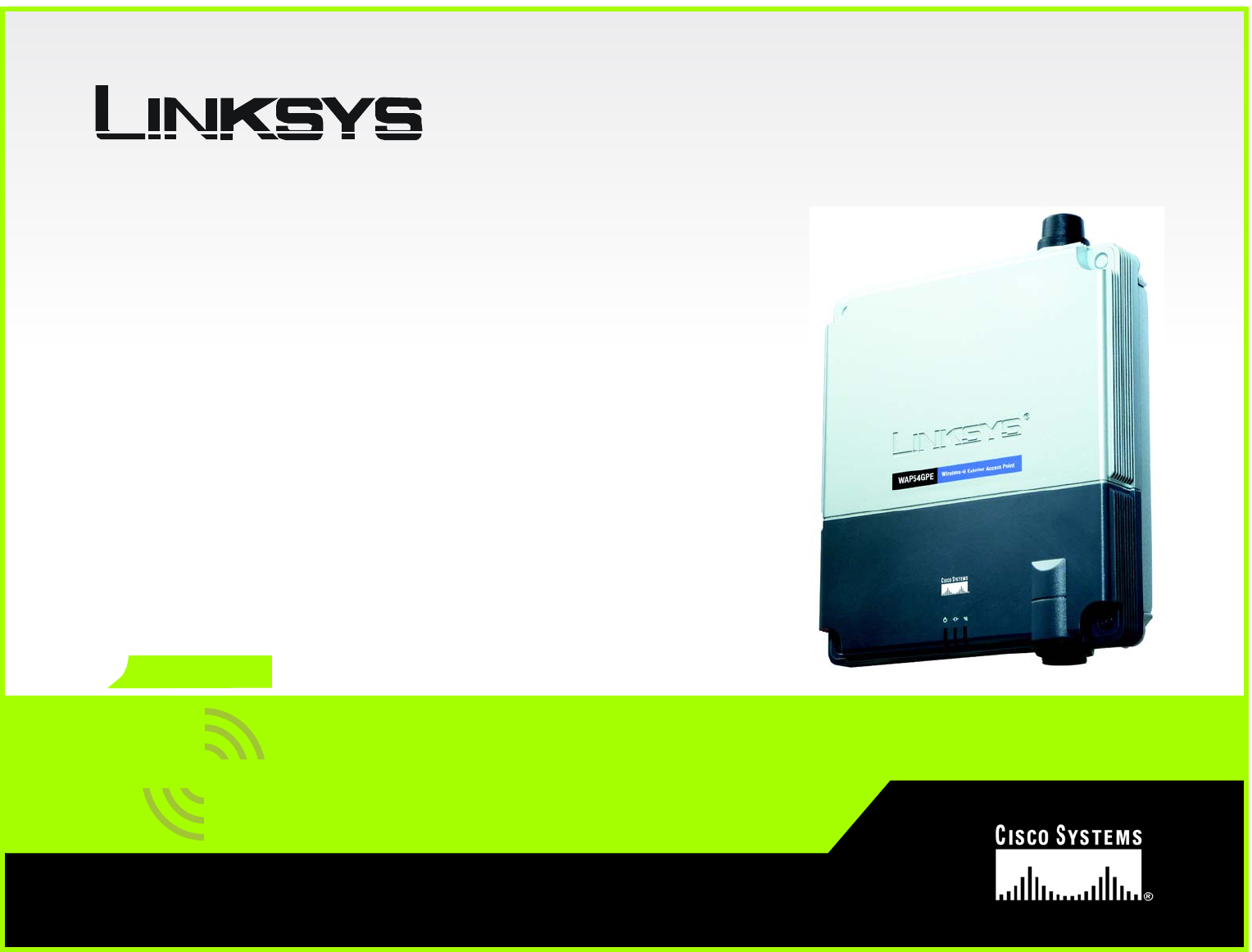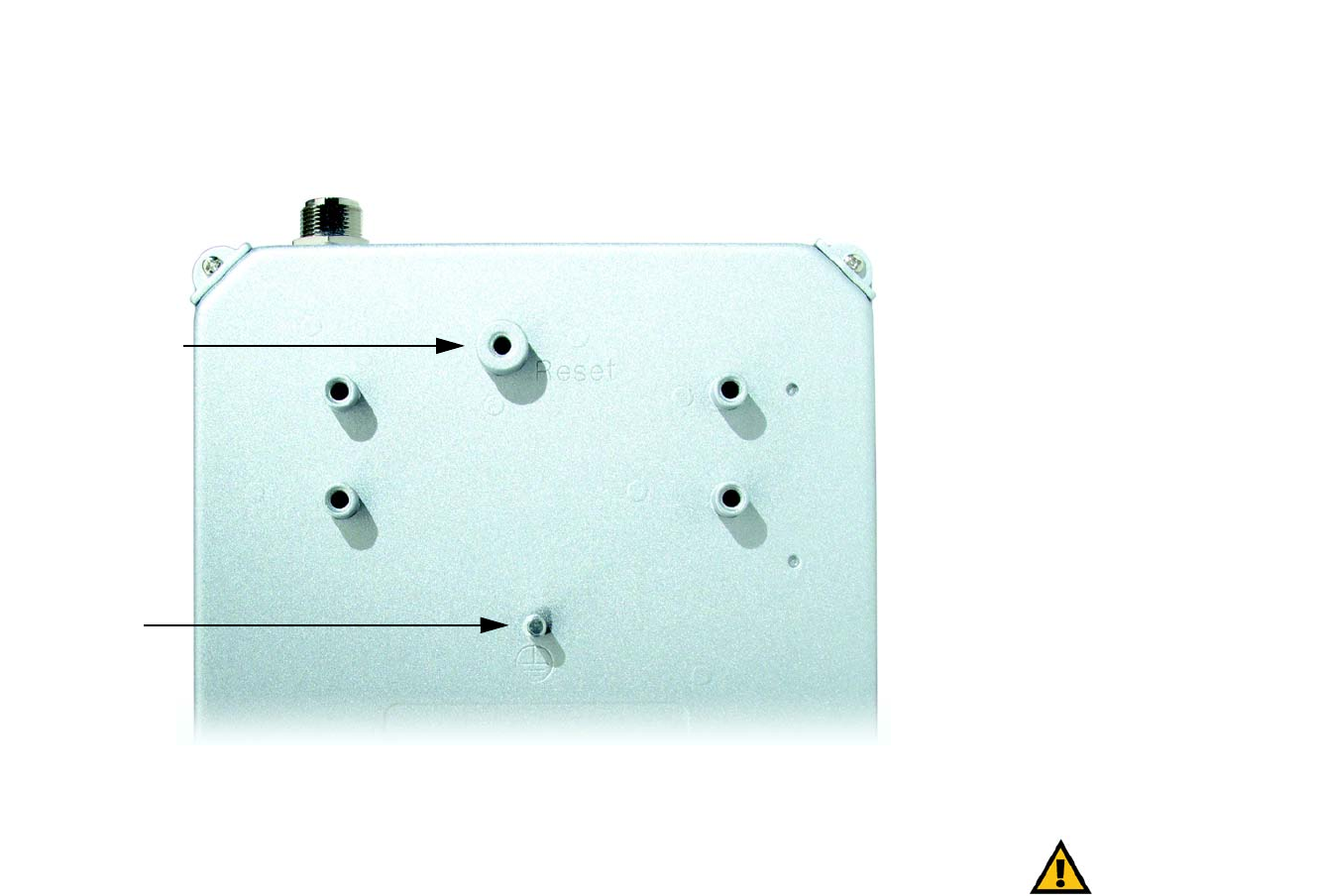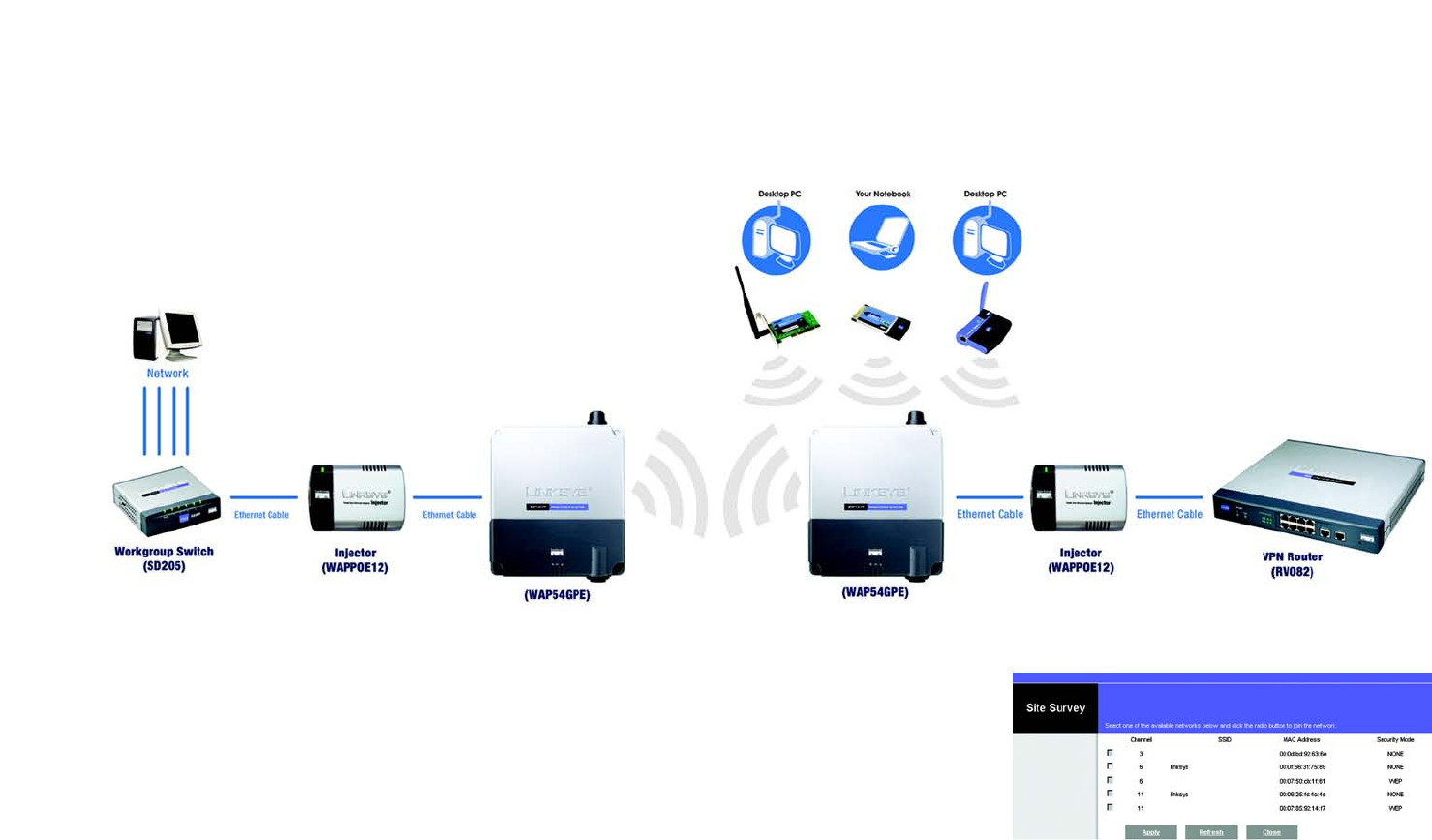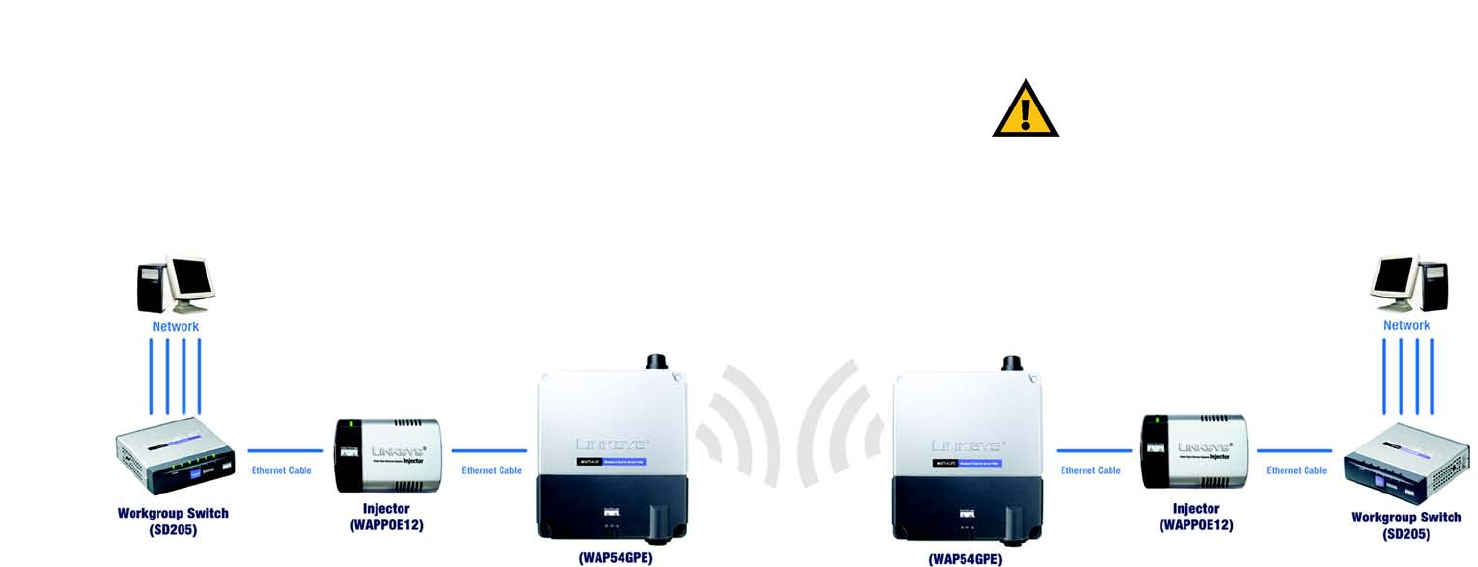LINKSYS HGA9NWAP54GPE Wireless-G Exterior Access Point with POE User Manual Book
LINKSYS LLC Wireless-G Exterior Access Point with POE Book
LINKSYS >
Manual

A Division of Cisco Systems, Inc.
®
Model No.
Exterior Access Point
Wireless-G
WAP54GPE
User Guide
WIRELESS
GHz
2.4
802.11g

Wireless-G Exterior Access Point
Copyright and Trademarks
Specifications are subject to change without notice. Linksys is a registered trademark or trademark of Cisco
Systems, Inc. and/or its affiliates in the U.S. and certain other countries. Copyright © 2004 Cisco Systems, Inc. All
rights reserved. Other brands and product names are trademarks or registered trademarks of their respective
holders.
How to Use this User Guide
The user guide to the Wireless-G Exterior Access Point has been designed to make understanding networking
with the Access Point easier than ever. Look for the following items when reading this User Guide:
In addition to these symbols, there are definitions for technical terms that are presented like this:
Also, each figure (diagram, screenshot, or other image) is provided with a figure number and description, like
this:
Figure numbers and descriptions can also be found in the “List of Figures” section.
This exclamation point means there is a caution or
warning and is something that could damage your
property or the Access Point.
word: definition.
This checkmark means there is a note of interest and
is something you should pay special attention to while
using the Access Point.
This question mark provides you with a reminder about
something you might need to do while using the Access Point.
Figure 0-1: Sample Figure Description
WAP54GPE-UG-41217NC JL
WARNING: This product contains chemicals, including lead, known
to the State of California to cause cancer, and birth defects or other
reproductive harm. Wash hands after handling.

Wireless-G Exterior Access Point
Table of Contents
Chapter 1: Introduction 1
Welcome 1
What’s in this User Guide? 2
Chapter 2: Planning Your Wireless Network 4
Network Topology 4
Roaming 4
Network Layout 4
Chapter 3: Getting to Know the Wireless-G Exterior Access Point 5
The LEDs 5
The Ports 6
The Reset Button and Ground 7
Chapter 4: Connecting the Wireless-G Exterior Access Point 8
Overview 8
Hardware Installation 8
Chapter 5: Setting Up the Wireless-G Exterior Access Point 10
Setup Wizard 10
Chapter 6: Configuring the Wireless-G Exterior Access Point 17
Overview 17
Navigating the Utility 17
Accessing the Utility 19
The Setup Tab 19
The Wireless - Basic Wireless Settings Tab 21
The Wireless - Wireless Security Tab 22
The Wireless - Wireless Network Access Tab 25
The Wireless - Advanced Wireless Settings Tab 25
The AP Mode Tab 27
The Administration - Management Tab 30
The Administration - Log Tab 31
The Administration - Factory Default Tab 33
The Administration - Firmware Upgrade Tab 33
The Administration - Language Upgrade Tab 34
The Administration - Reboot Tab 34

Wireless-G Exterior Access Point
The Administration - Config Management Tab 35
The Status - Local Network Tab 35
The Status - Wireless Tab 36
The Status - System Performance Tab 37
Appendix A: Troubleshooting 39
Frequently Asked Questions 39
Appendix B: Wireless Security 43
Security Precautions 43
Security Threats Facing Wireless Networks 43
Appendix C: Upgrading Firmware 46
Appendix D: Windows Help 47
Appendix E: Glossary 48
Appendix F: Specifications 55
Appendix G: Warranty Information 57
Appendix H: Regulatory Information 58
Appendix I: Contact Information 60

Wireless-G Exterior Access Point
List of Figures
Figure 3-1: Front Panel 5
Figure 3-2: Ethernet Network Port 6
Figure 3-3: Antenna Port 6
Figure 3-4: Reset Button 7
Figure 4-1: Mark the Locations of the Two Wall-Mount Slots 8
Figure 4-2: Attach the Mounting Plate 8
Figure 4-3: Ground the Access Point 9
Figure 4-4: Attach the Access Point to the Wall 9
Figure 5-1: Setup Wizard’s Welcome Screen 10
Figure 5-2: Connecting the Access Point 11
Figure 5-3: Select an Access Point 11
Figure 5-4: Login Screen 12
Figure 5-5: Configure Network Address Settings Screen 12
Figure 5-6: Wireless Settings Screen 13
Figure 5-7: Wireless Security Settings - WEP Screen 14
Figure 5-8: Wireless Security Settings - WPA-Personal Screen 15
Figure 5-9: Wireless Power Management Screen 15
Figure 5-10: Confirmation Screen 16
Figure 5-11: Congratulations Screen 16
Figure 6-1: Login Screen 19
Figure 6-2: Setup - Automatic Configuration - DHCP Screen 19
Figure 6-3: Setup - Static IP Address Screen 20
Figure 6-4: Wireless - Basic Wireless Settings Screen 21
Figure 6-5: Wireless - Wireless Security (WPA Pre-Shared Key) Screen 22
Figure 6-6: Wireless Security - WPA RADIUS Screen 23
Figure 6-7: Wireless Security - RADIUS Screen 24
Figure 6-8: Wireless Settings - WEP Screen 24
Figure 6-9: Wireless - Wireless Network Access Screen 25

Wireless-G Exterior Access Point
Figure 6-10: Wireless - Advanced Wireless Settings Screen 25
Figure 6-11: AP Mode Screen 27
Figure 6-12: Wireless Repeater Diagram 28
Figure 6-13: Site Survey Screen 28
Figure 6-14: Wireless Bridge Diagram 29
Figure 6-15: Administration - Management Screen 30
Figure 6-16: The Administration - Log Screen 31
Figure 6-17: Administration - Factory Default Screen 33
Figure 6-18: Administration - Firmware Upgrade Screen 33
Figure 6-19: Administration - Language Upgrade Screen 34
Figure 6-20: Administration - Reboot Screen 34
Figure 6-21: Administration - Config Management Screen 35
Figure 6-22: Status - Local Network Screen 35
Figure 6-23: Status - Wireless Screen 36
Figure 6-24: Status - System Performance Screen 37
Figure C-1: Firmware Upgrade 46

1
Chapter 1: Introduction
Welcome
Wireless-G Exterior Access Point
Chapter 1: Introduction
Welcome
Thank you for choosing the Wireless-G Exterior Access Point. This Access Point will allow you to network
wirelessly better than ever.
How does the Access Point do all of this? An access point allows for greater range and mobility within your
wireless network while also allowing you to connect the wireless network to a wired environment. In fact, the
Wireless-G Exterior Access Point can support communications on up to eight wireless networks, using Virtual
Local Area Network (VLAN) technology.
The Wireless-G Exterior Access Point also offers the convenience of Power over Ethernet (PoE) capability, so it
can receive data and power over a single Ethernet network cable. And with the advantage of its weather-proof
housing, you can mount the Access Point outside to extend your wireless networking range and mobility to the
outdoors. You can even connect wired networks in two different buildings, by using two Access Points set to
Wireless Bridge mode.
But what does all of this mean?
Networks are useful tools for sharing computer resources. You can access one printer from different computers
and access data located on another computer's hard drive. Networks are even used for playing multiplayer video
games. So, networks are not only useful in homes and offices, they can also be fun.
PCs on a wired network create a LAN, or Local Area Network. They are connected with Ethernet cables, which is
why the network is called "wired".
PCs equipped with wireless cards and adapters can communicate without cumbersome cables. By sharing the
same wireless settings, within their transmission radius, they form a wireless network. This is sometimes called
a WLAN, or Wired Local Area Network. The Access Point bridges wireless networks of both 802.11g and 802.11b
standards and wired networks.
Use the instructions in this Guide to help you connect the Access Point, set it up, and configure it to bridge your
different networks. These instructions should be all you need to get the most out of the Access Point.
802.11b: a wireless networking standard that specifies a
maximum data transfer rate of 11Mbps and an operating
frequency of 2.4GHz.
802.11g: a wireless networking standard that specifies a
maximum data transfer rate of 54Mbps, an operating
frequency of 2.4GHz, and backward compatibility with
802.11b devices.
adapter: a device that adds network functionality to your
PC.
ethernet: network protocol that specifies how data is
placed on and retrieved from a common transmission
medium.
lan (local area network): the computers and networking
products that make up your local network.
network: a series of computers or devices connected
together.
poe (power over ethernet): a technology enabling an
Ethernet network cable to deliver both data and power.
access point: a device that allows wireless-equipped
computers and other devices to communicate with a wired
network. Also used to expand the range of a wireless
network.

2
Chapter 1: Introduction
What’s in this User Guide?
Wireless-G Exterior Access Point
What’s in this User Guide?
This user guide covers the steps for setting up and using the Wireless-G Exterior Access Point.
• Chapter 1: Introduction
This chapter describes the Wireless-G Exterior Access Point’s applications and this User Guide.
• Chapter 2: Planning your Wireless Network
This chapter describes the basics of wireless networking.
• Chapter 3: Getting to Know the Wireless-G Exterior Access Point
This chapter describes the physical features of the Access Point.
• Chapter 4: Connecting the Wireless-G Exterior Access Point
This chapter instructs you on how to connect the Access Point to your network.
• Chapter 5: Setting Up the Wireless-G Exterior Access Point
This chapter explains how to use the Setup Wizard to configure the settings on the Access Point.
• Chapter 6: Configuring the Wireless-G Exterior Access Point
This chapter explains how to use the Access Point’s Web-based Utility for advanced configuration.
• Appendix A: Troubleshooting
This appendix describes some frequently asked questions regarding installation and use of the Wireless-G
Exterior Access Point.
• Appendix B: Wireless Security
This appendix explains the risks of wireless networking and some solutions to reduce the risks.
• Appendix C: Upgrading Firmware
This appendix instructs you on how to upgrade the Access Point’s firmware.
• Appendix D: Windows Help.
This appendix describes some of the ways Windows can help you with wireless networking.
• Appendix E: Glossary
This appendix gives a brief glossary of terms frequently used in networking.
• Appendix F: Specifications
This appendix provides the Access Point’s technical specifications.

3
Chapter 1: Introduction
What’s in this User Guide?
Wireless-G Exterior Access Point
• Appendix G: Warranty Information
This appendix supplies the Access Point’s warranty information.
• Appendix H: Regulatory Information
This appendix supplies the Access Point’s regulatory information.
• Appendix I: Contact Information
This appendix provides contact information for a variety of Linksys resources, including Technical Support.

4
Chapter 2: Planning Your Wireless Network
Network Topology
Wireless-G Exterior Access Point
Chapter 2: Planning Your Wireless Network
Network Topology
A wireless network is a group of computers, each equipped with one wireless adapter. Computers in a wireless
network must be configured to share the same radio channel. Several PCs equipped with wireless cards or
adapters can communicate with one another to form an ad-hoc network.
Linksys wireless adapters also provide users access to a wired network when using an access point, such as the
Wireless-G Exterior Access Point, or wireless router. An integrated wireless and wired network is called an
infrastructure network. Each wireless PC in an infrastructure network can talk to any computer in a wired
network infrastructure via the access point or wireless router.
An infrastructure configuration extends the accessibility of a wireless PC to a wired network, and may double the
effective wireless transmission range for two wireless adapter PCs. Since an access point is able to forward data
within a network, the effective transmission range in an infrastructure network may be doubled.
Roaming
Infrastructure mode also supports roaming capabilities for mobile users. Roaming means that you can move your
wireless PC within your network and the access points will pick up the wireless PC's signal, providing that they
both share the same channel and SSID.
Before enabling you consider roaming, choose a feasible radio channel and optimum access point position.
Proper access point positioning combined with a clear radio signal will greatly enhance performance.
Network Layout
The Wireless-G Exterior Access Point has been designed for use with 802.11g and 802.11b products. The Access
Point is compatible with 802.11g and 802.11b adapters, such as the Notebook Adapters for your laptop
computers, PCI Adapters for your desktop PCs, and USB Adapters for when you want to enjoy USB connectivity.
These wireless products can also communicate with a 802.11g or 802.11b Wireless PrintServer.
To link your wired network with your wireless network, connect the Access Point’s Ethernet network port to any
switch or router with Power over Ethernet (PoE)—or a PoE injector, such as the Linksys WAPPOE or WAPPOE12.
With these, and many other, Linksys products, your networking options are limitless. Go to the Linksys website at
www.linksys.com for more information about wireless products.
infrastructure: a wireless network that is bridged to a wired
network via an access point.
ad-hoc: a group of wireless devices communicating directly
with each other (peer-to-peer) without the use of an access
point.
roaming: the ability to take a wireless device from one
access point's range to another without losing the
connection.
ssid: your wireless network's name

5
Chapter 3: Getting to Know the Wireless-G Exterior Access Point
The LEDs
Wireless-G Exterior Access Point
Chapter 3: Getting to Know the Wireless-G Exterior Access
Point
The LEDs
The Access Point's LEDs, where information about network activity is displayed, are located on the front panel.
(Power) Green. The power LED lights up when the Access Point is powered on.
(Wired) Green. The wired LED lights up when the Access Point is successfully connected to a device
through the Ethernet network port. If the wired LED is flashing, the Access Point is actively
sending to or receiving data from one of the devices over the Ethernet network port.
(Wireless) Green. The wireless LED lights up when the Access Point is successfully connected to a
wireless device. If the wireless LED is flashing, the Access Point is actively sending to or
receiving data from a wireless device.
Figure 3-1: Front Panel

6
Chapter 3: Getting to Know the Wireless-G Exterior Access Point
The Ports
Wireless-G Exterior Access Point
The Ports
The Access Point's Ethernet network port is located on the bottom panel, while the antenna port is located on the
top panel.
Ethernet
(Ethernet) The Ethernet network port connects to Ethernet network devices, such as a switch or router
that supports Power over Ethernet (PoE).
Antenna
(Antenna) The Access Point has a built-in, internal patch antenna. It also has a male N-type antenna port
for an optional, high-gain external antenna.
Figure 3-2: Ethernet Network Port
Figure 3-3: Antenna Port
port: the connection point on a computer or
networking device used for plugging in
cables or adapters

7
Chapter 3: Getting to Know the Wireless-G Exterior Access Point
The Reset Button and Ground
Wireless-G Exterior Access Point
The Reset Button and Ground
The Access Point's Reset button and ground are located on the back panel.
Reset Button
Reset There are two ways to Reset the Access Point's factory defaults. Either press the Reset
button, for approximately ten seconds, or restore the defaults using the Access Point's Web-
based Utility.
Ground
(Ground) Before you mount the Access Point, you must ground the Access Point as a precaution.
Figure 3-4: Reset Button
Reset Button
Ground
IMPORTANT: Resetting the Access Point will
erase all of your settings (including wireless
security, IP address, and power output) and
replace them with the factory defaults. Do not
reset the Access Point if you want to retain
these settings.

8
Chapter 4: Connecting the Wireless-G Exterior Access Point
Overview
Wireless-G Exterior Access Point
Chapter 4: Connecting the Wireless-G Exterior Access Point
Overview
This chapter explains how to mount and connect the Access Point.
Hardware Installation
1. Locate an optimum location for the Access Point.
2. Use the mounting plate as a template. On the wall you have chosen, mark the locations of the two wall-mount
slots at the bottom of the mounting plate.
3. Attach two screws (not included) to the wall, so that the Access Point’s wall-mount slots line up with the two
screws.
4. Use four screws (included with the Access Point) to attach the mounting plate to the back panel of the Access
Point.
5. Connect the included Category 5e Ethernet network cable to the Ethernet network port of the Access Point.
Then screw the connector cap tightly onto the port, so the Access Point has a water-resistant seal.
6. If you want to connect the optional, high-gain external antenna, unscrew the cap protecting the Type-N
antenna port. Then connect your antenna to this port.
hardware: the physical aspect of
computers, telecommunications, and
other information technology devices.
Figure 4-1: Mark the Locations of the Two Wall-Mount Slots
Figure 4-2: Attach the Mounting Plate

9
Chapter 4: Connecting the Wireless-G Exterior Access Point
Hardware Installation
Wireless-G Exterior Access Point
7. Make sure you properly ground the Access Point.
8. Maneuver the Access Point so the two screws on the wall are inserted into the Access Point’s wall-mount
slots. Then slide the Access Point down so the screws fit snugly in the slots.
9. Attach two screws (not included) at the top of the mounting plate so the Access Point is securely mounted.
10. Connect the other end of the Ethernet network cable to a switch, router, or other device that supports Power
over Ethernet. The Access Point will then be connected to your wired network.
Now that the hardware installation is complete, proceed to “Chapter 5: Setting Up the Wireless-G Exterior Access
Point,” for directions on how to configure the Access Point.
Figure 4-4: Attach the Access Point to the Wall
Figure 4-3: Ground the Access Point

10
Chapter 5: Setting Up the Wireless-G Exterior Access Point
Setup Wizard
Wireless-G Exterior Access Point
Chapter 5: Setting Up the Wireless-G Exterior Access Point
Setup Wizard
Now that you've connected the Access Point to your wired network, you are ready to begin setting it up. This
Setup Wizard will take you through all the steps necessary to configure the Access Point.
1. Insert the Setup Wizard CD into your PC's CD-ROM drive. Your PC must be on your wired network to set up the
Access Point.
2. The Setup Wizard's Welcome screen should appear on your monitor. If it does not, then click the Start button
and select Run. In the field provided, enter D:\setup.exe (if “D” is the letter of your PC's CD-ROM drive).
Click the Setup button to proceed with this Setup Wizard. Clicking the User Guide button opened this Guide.
To exit this Setup Wizard, click the Exit button.
Figure 5-1: Setup Wizard’s Welcome Screen

11
Chapter 5: Setting Up the Wireless-G Exterior Access Point
Setup Wizard
Wireless-G Exterior Access Point
3. The next screen displayed shows how the Access Point should be connected as you run the Setup Wizard.
Optimally, you should perform this setup through a PC on your wired network. Click the Next button to
continue or Exit to exit the Setup Wizard.
4. The Setup Wizard will run a search for the Access Point within your network and then display a list along with
the status information for the selected access point. If this is the only access point on your network, it will be
the only one displayed. If there are more than one displayed, select the Access Point by clicking on it. Then
click the Yes button to continue or No to exit the Setup Wizard.
Figure 5-3: Select an Access Point
Figure 5-2: Connecting the Access Point

12
Chapter 5: Setting Up the Wireless-G Exterior Access Point
Setup Wizard
Wireless-G Exterior Access Point
5. You will be asked to sign onto the Access Point you have selected. Enter the default user name and password,
admin, in both fields. Then, click Enter. (This user name and password can be changed from the Web-based
Utility's Administration - Management tab.)
6. The Configure Network Address Settings screen will appear next. If your network router will automatically
assign an IP address to the Access Point, then select Automatically obtain an IP address (DHCP).
If you want to assign a static or fixed IP address to the Access Point, then select Set IP configuration
manually. Enter an IP Address, a Subnet Mask, and the IP address of your network gateway.
Then, click the Next button to continue or Back to return to the previous page.
• IP Address. This IP address must be unique to your network. (The default IP address is 192.168.1.245.)
• Subnet Mask. The Access Point's Subnet Mask must be the same as the subnet mask of your Ethernet
network.
• Gateway. This IP address should be the IP address of the gateway between the Internet and the local
network. (If you do not have a gateway, then enter the IP address of your network router.)
Figure 5-4: Login Screen
Figure 5-5: Configure Network Address Settings Screen
ip address: the address used to identify a computer
or device on a network.
ip (internet protocol): a protocol used to send data over
a network.
gateway: a device that interconnects networks with
different, incompatible communications protocols.
dhcp (dynamic host configuration protocol): a networking
protocol that allows administrators to assign temporary IP
addresses to network computers by “leasing” an IP address
to a user for a limited amount of time, instead of assigning
permanent IP addresses.
subnet mask: an address code that determines the
size of the network.

13
Chapter 5: Setting Up the Wireless-G Exterior Access Point
Setup Wizard
Wireless-G Exterior Access Point
7. The Wireless Settings screen should now appear. The Access Point can connect to up to eight wireless
networks at the same time. On this screen, you can configure up to three wireless networks and the Access
Point’s wireless mode. (If you want to configure additional networks, then use the Web-based Utility.)
Select Main SSID and enter your primary SSID in the field provided. Then select the channel at which the
network broadcasts its wireless signal.
Select the wireless mode you want the Access Point to use for all of the wireless networks it supports.
Select SSID 2 and enter your second SSID in the field provided. Then select this network’s channel setting.
Select SSID 3 and enter your third SSID in the field provided. Then select this network’s channel setting.
After you have entered the settings for your three wireless networks, click the Next button to continue or
Back to return to the previous page.
• SSID. The SSID is the unique name shared among all devices in a wireless network. It is case-sensitive
and must not exceed 32 characters, which may be any keyboard character. Make sure this setting is the
same for all devices in your wireless network.
• Channel. Select the appropriate channel from the list provided to correspond with your network settings.
All devices in your wireless network must use the same channel in order to communicate.
• Mode. Select Mixed Mode if you want both Wireless-G and Wireless-B computers allowed on the
networks, but note that the speed will be reduced. Select G-Only for maximum speed with Wireless-G
products only. The final selection, B-Only, allows only Wireless-B products on the networks. You can also
disable wireless performance if you select Disable.
Figure 5-6: Wireless Settings Screen

14
Chapter 5: Setting Up the Wireless-G Exterior Access Point
Setup Wizard
Wireless-G Exterior Access Point
8. The Wireless Security Settings screen will appear next. From this screen, you can set the level of security you
desire for each of your three networks.
First, select the wireless network you want to configure, Main SSID, SSID 2, or SSID 3.
Then select from WEP (64-Bit), WEP (128-Bit), and WPA-Personal, and follow the appropriate instructions
below. If you want to use WPA-Enterprise, then select Disabled from the Security drop-down menu. (You will
have to use the Web-based Utility to set up WPA-Enterprise or RADIUS; for more information, refer to “Chapter
6: Configuring the Wireless-G Exterior Access Point.”)
After you have entered the settings for your three wireless networks, click the Next button to continue or
Back to return to the previous page.
For more information on wireless security, refer to “Appendix B: Wireless Security.”
• WEP (64-Bit) or WEP (128-Bit). Enter the Passphrase for your network. If want to manually enter the WEP
key, then leave the Passphrase field blank and enter the WEP key in the Key 1 field. The WEP key can
consist of the letters “A” through “F” and the numbers “0” through “9” and should be 10 characters in
length for 64-bit encryption or 26 characters in length for 128-bit encryption.
After you have entered the settings for your three wireless networks, click the Next button to continue or
Back to return to the previous page.
Figure 5-7: Wireless Security Settings - WEP Screen
bit: a binary digit.
wpa (wi-fi protected access): a wireless security protocol
using TKIP (Temporal Key Integrity Protocol) encryption,
which can be used in conjunction with a RADIUS server.
wep (wired equivalent privacy): a method of encrypting
network data transmitted on a wireless network for greater
security.
passphrase: used much like a password, a passphrase
simplifies the WEP encryption process by automatically
generating the WEP encryption keys for Linksys products.

15
Chapter 5: Setting Up the Wireless-G Exterior Access Point
Setup Wizard
Wireless-G Exterior Access Point
• WPA-Personal. With WPA-Personal, you will use TKIP or AES for encryption with dynamic keys. Then enter
a Pre-Shared Key of 8-63 characters.
After you have entered the settings for your three wireless networks, click the Next button to continue or
Back to return to the previous page.
9. The Wireless Power Management screen will appear. You can adjust the power output of the Access Point to
get the appropriate coverage for your wireless network. Select the setting appropriate for your environment.
If you are not sure which setting to choose, then keep the default setting, 100%. Click the Next button to
continue or Back to return to the previous page.
Figure 5-8: Wireless Security Settings - WPA-Personal Screen
Figure 5-9: Wireless Power Management Screen
tkip (temporal key integrity protocol): a wireless
encryption protocol that provides dynamic
encryption keys for each packet transmitted.

16
Chapter 5: Setting Up the Wireless-G Exterior Access Point
Setup Wizard
Wireless-G Exterior Access Point
10. On the Confirmation screen, make sure your new settings are correct. To save your new settings, click the
Yes button. If you do not want to save your changes, then click the No button.
11. At this point, the configuration performed with the Setup Wizard is complete. To configure any other Access
Points in your network, you can run this Setup Wizard again.
Click the Online Registration button to register the Access Point, or click the Exit button to exit the Setup
Wizard.
For more advanced configuration, you can go to “Chapter 6: Configuring the Wireless-G Exterior
Access Point.”
Figure 5-10: Confirmation Screen
Figure 5-11: Congratulations Screen

17
Chapter 6: Configuring the Wireless-G Exterior Access Point
Overview
Wireless-G Exterior Access Point
Chapter 6: Configuring the Wireless-G Exterior Access Point
Overview
The Access Point has been designed to be functional right out of the box, with the default settings in the Setup
Wizard. However, if you'd like to change these settings, the Access Point can be configured through your web
browser with the Web-based Utility. This chapter explains how to use the Utility.
The Utility can be accessed via Microsoft Internet Explorer or Netscape Navigator through use of a computer that
is networked with the Access Point.
For a basic network setup, most users only have to use the following screens of the Utility:
• Setup
On the Setup screen, enter your basic network settings here.
• Management
Click the Administration tab and then select the Management screen. The Access Point’s default password
is admin. To secure the Access Point, change the AP Password from its default.
Navigating the Utility
There are five main tabs: Setup, Wireless, AP Mode, Administration, and Status. Additional screens will be
available from most of the main tabs.
Setup
Enter the Host Name and settings for your Internet connection on this screen.
Wireless
You will use the Wireless tabs to enter a variety of wireless settings for the Access Point.
•Basic Wireless Settings. Enter the network mode, Virtual Local Area Network (VLAN) priority, SSIDs, and
transmit rates on this screen.
•Wireless Security. Use this screen to configure the Access Point’s security settings.
HAVE YOU:Enabled TCP/IP on your PCs? PCs
communicate over the network with this
protocol. Refer to “Appendix D: Windows Help”
for more information on TCP/IP.
NOTE: The Access Point is designed to
function properly after using the Setup Wizard.
This chapter is provided solely for those who
wish to perform more advanced configuration
or monitoring.
browser: an application that provides a way to
look at and interact with all the information on the
World Wide Web.
tcp/ip: a set of instructions PCs use to
communicate over a network.

18
Chapter 6: Configuring the Wireless-G Exterior Access Point
Navigating the Utility
Wireless-G Exterior Access Point
•Wireless Network Access. From this screen, you can permit or block access to your wireless network.
•Advanced Wireless Settings. Use this screen to configure the Access Point’s more advanced wireless
settings.
AP Mode
Use this screen to configure how the Access Point will work with other access points in your network.
Administration
You will use the Administration tabs to manage the Access Point.
•Management. This screen allows you to customize the password and Simple Network Management Protocol
(SNMP) settings.
•Log. Configure the Log settings for the Access Point on this screen.
•Factory Default. Use this screen to reset the Access Point to its factory default settings.
•Firmware Upgrade. Upgrade the Access Point’s firmware on this screen.
•Language Upgrade. On this screen, change the language of the Access Point’s Web-based Utility.
•Reboot. Use this screen to reboot the Access Point.
•Config Management. You can back up the configuration file for the Access Point, as well as save the backup
configuration file to the Access Point.
Status
You will be able to view status information for your local network, wireless networks, and network performance.
•Local Network. This screen will display current information on the Access Point and its local network.
•Wireless. This screen will display current information on the Access Point and its wireless networks.
•System Performance. This screen will display current information on the Access Point and its data
transmissions.
firmware: the programming code that runs a
networking device.
snmp: the standard e-mail protocol on the Internet.

19
Chapter 6: Configuring the Wireless-G Exterior Access Point
Accessing the Utility
Wireless-G Exterior Access Point
Accessing the Utility
To access the Web-based Utility of the Access Point, launch Internet Explorer or Netscape Navigator, and enter
the Access Point’s default IP address, 192.168.1.245, in the Address field. Press the Enter key.
Open your web browser and type the IP address you entered in the Setup Wizard. (The default IP address is
192.168.1.245.) (Should you need to learn what IP address the Access Point presently uses, run the Setup
Wizard again. It will scan the Access Point and give you its IP address.) Press the Enter key and the following
screen will appear. Enter admin in the User Name field. The first time you open the Web-based Utility, use the
default password, admin. (You can set a new password from the Administration - Management tab.) Then click
the OK button.
The Setup Tab
The first screen that appears is the Setup screen. This allows you to change the Access Point's general settings.
Setup
Enter a name for the Access Point.
Host Name. You may assign any name to the Access Point. Unique, memorable names are helpful, especially if
you are employing multiple access points on the same network.
Network Setup
The selections under this heading allow you to configure the Access Point’s IP setting(s).
AP IP Type
Select Automatic Configuration - DHCP if your network router will assign an IP address to the Access Point.
Figure 6-1: Login Screen
Figure 6-2: Setup - Automatic Configuration -
DHCP Screen

20
Chapter 6: Configuring the Wireless-G Exterior Access Point
The Setup Tab
Wireless-G Exterior Access Point
Select Static IP Address if you want to assign a static or fixed IP address to the Access Point. Then complete the
following:
•IP Address. The IP address must be unique to your network. We suggest you use the default IP address of
192.168.1.245.
•Subnet Mask. The Subnet Mask must be the same as that set on your Ethernet network.
Change these settings as described here and click Save Settings to apply your changes, or click Cancel
Changes to cancel your changes. Help information is displayed on the right-hand side of the screen.
Figure 6-3: Setup - Static IP Address Screen
static ip address: a fixed address assigned to a computer or
device that is connected to a network.

21
Chapter 6: Configuring the Wireless-G Exterior Access Point
The Wireless - Basic Wireless Settings Tab
Wireless-G Exterior Access Point
The Wireless - Basic Wireless Settings Tab
Change the wireless network settings on this screen. The Access Point can connect to up to eight wireless
networks at the same time, so this screen offers settings for up to eight different SSIDs.
Wireless Network
Configure the Access Point using the available settings. You can enter and save more than one configuration for
the Access Point. (In other words, the Access Point can support up to eight VLANs.)
Wireless Network Mode. Select Mixed and both Wireless-G and Wireless-B computers will be allowed on the
network, but the speed will be reduced. Select G-Only for maximum speed with Wireless-G products only. The
final selection, B-Only, allows only Wireless-B products on the network. You can also disable wireless
performance if you select Disabled.
VLAN Priority. Select Enabled if you want to use the Access Point’s capability to assign VLAN priorities. Select
Disabled if you want to disable the Access Point’s capability to assign VLAN priorities.
SSID. You can enter settings for up to eight wireless networks, one primary (the first one listed) and seven
alternative ones.
SSID Name. The SSID is the unique name shared among all devices in a wireless network. It is case-sensitive
and must not exceed 32 alphanumeric characters, which may be any keyboard character. Make sure this setting
is the same for all devices in your wireless network.
VLAN Priority. You can assign VLAN priority to each wireless network, Low, Medium, or High.
TX Rate. The default setting is 54 Mbps. The range is from 1 to 54Mbps. The rate of data transmission should be
set depending on the speed of your wireless network. You can select from a range of transmission speeds, or you
can keep the default setting, 54 Mbps, to have the Access Point enable the Auto-Fallback feature. Auto-Fallback
will automatically negotiate the best possible connection speed between the Access Point and a wireless device.
Wireless Channel. Select the appropriate channel from the list provided to correspond with your network
settings. All devices in your wireless network must use the same channel in order to function correctly.
Wireless SSID Broadcast. This feature allows the primary SSID to be broadcast on your network. You may want
to enable this function while configuring your network, but make sure that you disable it when you are finished.
With this enabled, someone could easily obtain the SSID information with site survey software and gain
unauthorized access to your network. Click Enabled to broadcast the primary SSID to all wireless devices in
range. Click Disabled to increase network security and prevent the primary SSID from being seen on networked
PCs.
Figure 6-4: Wireless - Basic Wireless Settings Screen

22
Chapter 6: Configuring the Wireless-G Exterior Access Point
The Wireless - Wireless Security Tab
Wireless-G Exterior Access Point
Change these settings as described here and click Save Settings to apply your changes, or click Cancel
Changes to cancel your changes. Help information is displayed on the right-hand side of the screen, and click
More for additional details.
The Wireless - Wireless Security Tab
Change the Access Point’s wireless security settings on this screen.
Wireless Security
Enter the security settings for each SSID of the Access Point.
Select SSID. Select the SSID whose security settings you want to configure.
Security Mode. Select the security method you want to use, WPA-Personal, WPA-Enterprise, RADIUS, or WEP.
(WPA stands for Wi-Fi Protected Access, which is a security standard stronger than WEP encryption. WEP stands
for Wired Equivalent Privacy, while RADIUS stands for Remote Authentication Dial-In User Service.) Refer to the
appropriate instructions below after you select the Authentication Type and SSID Interoperability settings. For
detailed instructions on configuring wireless security for the Access Point, turn to “Appendix B: Wireless
Security.” To disable such security, select Disable.
Authentication Type. If you select WPA-Personal or WPA-Enterprise, then select WPA.
If you select RADIUS or WEP, or if you disable wireless security, select the authentication method you want the
Access Point to use, Shared Key or Open Key. Shared Key is when both the sender and the recipient share a
WEP key for authentication. Open Key is when the sender and the recipient do not share a WEP key for
authentication. All devices on your network must use the same authentication type.
SSID Interoperability. When enabled, the devices of the designated wireless network will have access to the
other wireless networks configured on the Access Point. If you want devices of the designated wireless network
to have access to other wireless networks, select Enabled. Otherwise, select Disabled.
WPA-Personal
WPA Algorithms. WPA offers you two encryption methods, TKIP and AES, with dynamic encryption keys. Select
the type of algorithm you want to use, TKIP or AES.
WPA Shared Key. Enter a WPA Shared Key of 8-32 characters.
Key Renewal Timeout. Enter a Key Renewal Timeout period, which instructs the Access Point how often it
should change the encryption keys.
Figure 6-5: Wireless - Wireless Security
(WPA Pre-Shared Key) Screen
encryption: encoding data transmitted in a network.

23
Chapter 6: Configuring the Wireless-G Exterior Access Point
The Wireless - Wireless Security Tab
Wireless-G Exterior Access Point
WPA-Enterprise
This option features WPA used in coordination with a RADIUS server. (This should only be used when a RADIUS
server is connected to the Access Point.)
RADIUS Server IP Address. Enter the RADIUS server’s IP address.
WPA Algorithms. WPA offers you two encryption methods, TKIP and AES, with dynamic encryption keys. Select
the type of algorithm you want to use, TKIP or AES.
WPA Shared Key. Enter a WPA Shared Key of 8-32 characters.
RADIUS Server Port. Enter the port number used by the RADIUS server.
Shared Secret. Enter the Shared Secret key used by the Access Point and RADIUS server.
Key Renewal Timeout. Enter a Key Renewal Timeout period, which instructs the Access Point how often it
should change the encryption keys.
Figure 6-6: Wireless Security - WPA RADIUS Screen
radius: a protocol that uses an authentication server to
control network access.
server: any computer whose function in a network is to
provide user access to files, printing, communications, and
other services.

24
Chapter 6: Configuring the Wireless-G Exterior Access Point
The Wireless - Wireless Security Tab
Wireless-G Exterior Access Point
RADIUS
RADIUS Server IP Address. Enter the RADIUS server’s IP address.
RADIUS Server Port. Enter the port number used by the RADIUS server.
Shared Secret. Enter the Shared Secret key used by the Access Point and RADIUS server.
Default Transmit Key. Select a Default Transmit Key (choose which Key to use).
WEP Encryption. Select a level of WEP encryption, 64 bits (10 hex digits) or 128 bits (26 hex digits).
Passphrase. If you want to generate WEP keys using a Passphrase, then enter the Passphrase in the field
provided and click the Generate key.
Key 1-4. If you want to manually enter WEP keys, then complete the fields provided. Each WEP key can consist of
the letters “A” through “F” and the numbers “0” through “9”. It should be 10 characters in length for 64-bit
encryption or 26 characters in length for 128-bit encryption.
WEP
WEP Encryption. Select a level of WEP encryption, 64 bits (10 hex digits) or 128 bits (26 hex digits).
Passphrase. If you want to generate WEP keys using a Passphrase, then enter the Passphrase in the field
provided and click the Generate key.
Key 1-4. If you want to manually enter WEP keys, then complete the fields provided. Each WEP key can consist of
the letters “A” through “F” and the numbers “0” through “9”. It should be 10 characters in length for 64-bit
encryption or 26 characters in length for 128-bit encryption.
Change these settings as described here and click Save Settings to apply your changes, or click Cancel
Changes to cancel your changes. Help information is displayed on the right-hand side of the screen, and click
More for additional details.
Figure 6-8: Wireless Settings - WEP Screen
Figure 6-7: Wireless Security - RADIUS Screen

25
Chapter 6: Configuring the Wireless-G Exterior Access Point
The Wireless - Wireless Network Access Tab
Wireless-G Exterior Access Point
The Wireless - Wireless Network Access Tab
This screen allows you to permit or block wireless access for computers with specific MAC addresses.
Wireless Network Access
You can allow or block access for the MAC addresses you have entered.
Access List. To permit access, click Permit to access. To deny access, click Prevent from accessing. If you do
not wish to filter users by MAC address, select Disabled.
MAC 1-20. Enter the MAC addresses of the computers whose access you want to control.
Change these settings as described here and click Save Settings to apply your changes, or click Cancel
Changes to cancel your changes. Help information is displayed on the right-hand side of the screen.
The Wireless - Advanced Wireless Settings Tab
This screen allows you to configure the advanced settings for the Access Point. In most cases, these settings do
not need to be changed.
Advanced Wireless
You can change the data transmission and output power settings for the Access Point.
CTS Protection Mode. CTS (Clear-To-Send) Protection Mode function boosts the Access Point’s ability to catch
all Wireless-G transmissions but will severely decrease performance. Keep the default setting, Auto, so the
Access Point can use this feature as needed, when the Wireless-G products are not able to transmit to the Access
Point in an environment with heavy 802.11b traffic. Select Enabled if you want to permanently enable this
feature, or select Disabled if you want to permanently disable this feature.
Wireless Isolation. In most cases, keep the default, Disabled. Select Enabled if you do not want your wired and
wireless networks to communicate; for example, if you have a wireless hotspot, you may want to keep the
wireless network isolated from your wired network.
Basic Data Rates. This setting is not actually one rate of transmission but a series of rates that are advertised to
the other wireless devices in your network, so they know at which rates the Access Point can transmit. At the
Default setting, the Access Point will advertise that it will automatically select the best rate for transmission.
Other options are 1-2Mbps, for use with older wireless technology, and All, when you wish to have all rates
Figure 6-10: Wireless - Advanced Wireless
Settings Screen
Figure 6-9: Wireless - Wireless Network Access Screen
cts (clear-to-send): a signal sent by a wireless device,
signifying that it is ready to receive data.
mac address: the unique address that a manufacturer
assigns to each networking device.

26
Chapter 6: Configuring the Wireless-G Exterior Access Point
The Wireless - Advanced Wireless Settings Tab
Wireless-G Exterior Access Point
advertised. The Basic Data Rates are not the rates transmitted; the rates transmitted can be configured through
the TX Rate setting on the Wireless - Basic Wireless Settings tab.
Beacon Interval. This value indicates the frequency interval of the beacon. A beacon is a packet broadcast by
the Access Point to keep the network synchronized. A beacon includes the wireless networks service area, the
Access Point address, the Broadcast destination addresses, a time stamp, Delivery Traffic Indicator Maps, and
the Traffic Indicator Message (TIM).
DTIM Interval. This value indicates how often the Access Point sends out a Delivery Traffic Indication Message
(DTIM). Lower settings result in more efficient networking, while preventing your PC from dropping into power-
saving sleep mode. Higher settings allow your PC to enter sleep mode, thus saving power, but interferes with
wireless transmissions.
RTS Threshold. This setting determines how large a packet can be before the Access Point coordinates
transmission and reception to ensure efficient communication. This value should remain at its default setting of
2347. Should you encounter inconsistent data flow, only minor modifications are recommended.
Fragmentation Threshold. This specifies the maximum size a data packet can be before splitting and creating
a new packet. It should remain at its default setting of 2346. A smaller setting means smaller packets, which will
create more packets for each transmission. If you have decreased this value and experience high packet error
rates, you can increase it again, but it will likely decrease overall network performance. Only minor modifications
of this value are recommended.
Output Power. You can adjust the output power of the Access Point to get the appropriate coverage for your
wireless network. Select the level you need for your environment. If you are not sure which setting to choose,
then keep the default setting, 100%.
Change these settings as described here and click Save Settings to apply your changes, or click Cancel
Changes to cancel your changes. Help information is displayed on the right-hand side of the screen, and click
More for additional details.
beacon internal: data transmitted on your wireless network
that keeps the network synchronized.
rts (request to send): a networking method of coordinating
large packets through the RTS Threshold setting.
dtim (delivery traffic indication message): a message
included in data packets that can increase wireless
efficiency.
fragmentation: breaking a packet into smaller units
when transmitting over a network.
packet: a unit of data sent over a network.

27
Chapter 6: Configuring the Wireless-G Exterior Access Point
The AP Mode Tab
Wireless-G Exterior Access Point
The AP Mode Tab
On this screen you can change the Access Point’s mode of operation. In most cases, you can keep the default,
Access Point. You may wish to do this if you want to use the Access Point as a wireless repeater to extend the
range of your wireless network. You may also wish to do this if you want to use the Access Point as a wireless
bridge; for example, you can use two Access Points in Wireless Bridge mode to connect two wired networks that
are in two different buildings.
AP Mode
The Access Point offers three modes of operation: Access Point, Wireless Repeater, and Wireless Bridge. For the
Repeater and Bridge modes, make sure the SSID, channel, and security settings are the same for the other
wireless access points/devices.
MAC Address
The MAC address of the Access Point is displayed here.
Access Point. The Mode is set to Access Point by default. This connects your wireless PCs to a wired network.
In most cases, no change is necessary. If you want to let the Access Point’s signal be repeated, then click the
checkbox next to Allow wireless signal to be repeated by a repeater. For example, you can use the Access Point
with the Linksys Wireless-G Range Expander (model number: WRE54G).
Figure 6-11: AP Mode Screen
IMPORTANT: For all modes of operation EXCEPT Access Point, the remote access point must be a
second Linksys Wireless Access Point (for Wireless Repeater mode, a Wireless-G Broadband Router is
also compatible). The Access Point will not communicate with any other kind of remote access point.

28
Chapter 6: Configuring the Wireless-G Exterior Access Point
The AP Mode Tab
Wireless-G Exterior Access Point
Wireless Repeater. When set to Wireless Repeater mode, the Wireless Repeater is able to talk to up to three
remote access points within its range and retransmit its signal. (This feature only works with the Linksys
Wireless-G Exterior Access Point (model number: WAG54GPE), Wireless-G Access Point (model number:
WAP54G), and Wireless-G Broadband Router (model number: WRT54G).
To configure a Wireless Repeater environment, click Wireless Repeater and enter the local MAC addresses of
the remote access points in the MAC 1-3 fields. If you do not know an access point’s MAC address, click the Site
Survey button. Select the access points you want to use and click the Apply button. Then click the Close button
to return to the AP Mode screen. If you do not see the access point you want, click the Refresh button to run
another site survey.
Figure 6-12: Wireless Repeater Diagram
Figure 6-13: Site Survey Screen

29
Chapter 6: Configuring the Wireless-G Exterior Access Point
The AP Mode Tab
Wireless-G Exterior Access Point
Wireless Bridge. This mode connects two physically separated wired networks with two access points. If you
are trying to create a wireless connection between two wired networks, select Wireless Bridge. and enter the
local MAC addresses of the wireless bridges/access points in the MAC 1-3 fields. If you do not know a wireless
bridge/access points’s MAC address, click the Site Survey button. Select the wireless bridges/access points you
want to use and click the Apply button. Then click the Close button to return to the AP Mode screen. If you do not
see the wireless bridge/access point you want, click the Refresh button to run another site survey. The remote
wireless bridges/access points also need to be set to Wireless Bridge mode.
Change these settings as described here and click Save Settings to apply your changes, or click Cancel
Changes to cancel your changes. Help information is displayed on the right-hand side of the screen, and click
More for additional details.
IMPORTANT: In Wireless Bridge mode, the Access
Point can ONLY be accessed by another access point
in Wireless Bridge mode. In order for your other
wireless devices to access the Access Point, you
must reset it to Access Point mode. The two modes
are mutually exclusive.
Figure 6-14: Wireless Bridge Diagram

30
Chapter 6: Configuring the Wireless-G Exterior Access Point
The Administration - Management Tab
Wireless-G Exterior Access Point
The Administration - Management Tab
On this screen you can configure the password and SNMP settings.
AP Password
You should change the password that controls access to the Access Point’s Web-based Utility.
Local AP Password
User Name. Create a User Name and enter it in the field provided.
AP Password. Create a Password for the Access Point’s Web-based Utility.
Re-enter to confirm. To confirm the new Password, enter it again in this field.
SNMP
SNMP is a popular network monitoring and management protocol. It provides network administrators with the
ability to monitor the status of the Access Point and receive notification of any critical events as they occur on the
Access Point.
To enable the SNMP support feature, select Enabled. Otherwise, select Disabled.
Identification
Contact. Enter the name of the contact person, such as a network administrator, for the Access Point.
Device Name. Enter the name you wish to give to the Access Point.
Location. Enter the location of the Access Point.
Get Community. Enter the password that allows read-only access to the Access Point’s SNMP information. The
default is public.
Set Community. Enter the password that allows read/write access to the Access Point’s SNMP information. The
default is private.
SNMP Trap-Community. Enter the password required by the remote host computer that will receive trap
messages or notices sent by the Access Point.
Figure 6-15: Administration - Management Screen

31
Chapter 6: Configuring the Wireless-G Exterior Access Point
The Administration - Log Tab
Wireless-G Exterior Access Point
SNMP Trusted Host. You can restrict access to the Access Point’s SNMP information by IP address. Enter the IP
address in the field provided. If this field is left blank, then access is permitted from any IP address.
SNMP Trap-Destination. Enter the IP address of the remote host computer that will receive the trap messages.
Change these settings as described here and click Save Settings to apply your changes, or click Cancel
Changes to cancel your changes. Help information is displayed on the right-hand side of the screen, and click
More for additional details.
The Administration - Log Tab
On this screen you can configure the log settings, as well as options for e-mail alerts of particular events.
Log
You can have logs that keep track of the Access Point’s activities.
Email Alert
E-Mail Alert. To enable the Access Point to send e-mail alerts in the event of certain attacks (see the “Alert Log”
section below), select Enabled. If you do not want to have e-mail alerts, select Disabled.
E-Mail Address for General Logs. Enter the e-mail address that will receive general logs.
E-Mail Address for Alert Logs. Enter the e-mail address that will receive alert logs.
Return E-Mail address. Your mail server may require a return e-mail address. If so, enter that address here. If
you are not sure about what address to enter, enter the same e-mail address you entered above for the E-Mail
Address for Alert Logs field.
E-Mail Server IP Address. Enter the IP address or full mail server name (e.g., mail.domain.com) of your mail
server.s
Syslog Notification
Syslog is a standard protocol used to capture information about network activity. The Access Point supports this
protocol and send its activity logs to an external server. To enable Syslog, select Enabled. If you do not want to
use Syslog, select Disabled.
Device Name. Enter a name for the Access Point.
Figure 6-16: The Administration - Log Screen

32
Chapter 6: Configuring the Wireless-G Exterior Access Point
The Administration - Log Tab
Wireless-G Exterior Access Point
Syslog Server IP Address. Enter the IP address of the Syslog server. In addition to the standard event log, the
Access Point can send a detailed log to an external Syslog server. The Access Point’s Syslog captures all log
activities and includes this information about all data transmissions: every connection source and destination IP
address, IP server, and number of bytes transferred.
Syslog Priority. Select the appropriate priority from the drop-down menu. The default is Information.
Notification Queue Length
Log Queue Length. You can designate the length of the log that will be e-mailed to you. The default is 20 entries.
Log Time Threshold. You can designate how often the log will be e-mailed to you. The default is 600 seconds
(10 minutes).
Alert Log
Syn Flooding. If you want to receive alert logs about any Syn Flooding events, click the checkbox.
IP Spoofing. If you want to receive alert logs about any IP Spoofing events, click the checkbox.
Win Nuke. If you want to receive alert logs about any Win Nuke events, click the checkbox.
Ping of Death. If you want to receive alert logs about any Ping of Death attacks, click the checkbox.
Unauthorized Login Attempt. If you want to receive alert logs about any unauthorized login attempts, click the
checkbox.
General Log
System Error Messages. If you want to log system error messages, click the checkbox.
Deny Policies. If you want to log any denial of access policies, click the checkbox.
Allow Policies. If you want to log any permission of access policies, click the checkbox.
Content Filtering. If you want to log any content filtering activities, click the checkbox.
Authorized Login. If you want to log authorized logins, click the checkbox.
Configuration Changes. If you want to log any configuration changes, click the checkbox.

33
Chapter 6: Configuring the Wireless-G Exterior Access Point
The Administration - Factory Default Tab
Wireless-G Exterior Access Point
Change these settings as described here and click Save Settings to apply your changes, or click Cancel
Changes to cancel your changes. Help information is displayed on the right-hand side of the screen, and click
More for additional details.
The Administration - Factory Default Tab
On this screen you can restore the Access Point’s factory default settings.
Factory Default
Write down any custom settings before you restore the factory defaults. Once the Access Point is reset, you will
have to re-enter all of your configuration settings.
Restore Factory Defaults. To restore the Access Point's factory default settings, click the Yes radio button.
Otherwise, click the No radio button.
Click Save Settings to apply your change, or click Cancel Changes to cancel your change. Help information is
displayed on the right-hand side of the screen.
The Administration - Firmware Upgrade Tab
On this screen you can upgrade the Access Point’s firmware. Do not upgrade the firmware unless you are
experiencing problems with the Access Point or the new firmware has a feature you want to use.
Firmware Upgrade
Before you upgrade the Access Point’s firmware, write down all of your custom settings. After you upgrade its
firmware, you will have to re-enter all of your configuration settings. To upgrade the Access Point’s firmware:
1. Download the firmware upgrade file from the Linksys website, www.linksys.com.
2. Extract the firmware upgrade file on your computer.
3. On the Firmware Upgrade screen, enter the location of the firmware upgrade file in the field provided, or click
the Browse button to find the file.
4. Click the Upgrade button, and follow the on-screen instructions.
Help information is displayed on the right-hand side of the screen.
Figure 6-18: Administration - Firmware Upgrade Screen
Figure 6-17: Administration - Factory Default Screen
upgrade: to replace existing software or
firmware with a newer version

34
Chapter 6: Configuring the Wireless-G Exterior Access Point
The Administration - Language Upgrade Tab
Wireless-G Exterior Access Point
The Administration - Language Upgrade Tab
On this screen you can do a language upgrade to change the language used by the Access Point’s Web-based
Utility.
Language Upgrade
If you do want to change the language currently used by the Web-based Utility, then you can download a
language upgrade file and update the Access Point.
To change the Access Point’s language:
1. Download the language upgrade file from the Linksys website, www.linksys.com.
2. Extract the language upgrade file on your computer.
3. On the Language Upgrade screen, enter the location of the language upgrade file in the field provided, or click
the Browse button to find the file.
4. Click the Upgrade button, and follow the on-screen instructions.
Help information is displayed on the right-hand side of the screen.
The Administration - Reboot Tab
On this screen you can reboot the Access Point.
Reboot
This feature is useful when you need to remotely reboot the Access Point.
Device Reboot. To reboot the Access Point, click the Yes radio button. Otherwise, click the No radio button.
Click Save Settings to apply your change, or click Cancel Changes to cancel your change. Help information is
displayed on the right-hand side of the screen.
Figure 6-19: Administration - Language Upgrade Screen
Figure 6-20: Administration - Reboot Screen

35
Chapter 6: Configuring the Wireless-G Exterior Access Point
The Administration - Config Management Tab
Wireless-G Exterior Access Point
The Administration - Config Management Tab
On this screen you can create a backup configuration file or save a configuration file to the Access Point.
Config Management
Use this screen to upload or download configuration files for the Access Point.
Download AP Config. To save a backup configuration file on a computer, click the Download AP Configuration
File button and follow the on-screen instructions.
Upload AP Config. To upload a configuration file to the Access Point, enter the location of the configuration file in
the field provided, or click the Browse button to find the file. Then click the Load radio button.
Help information is displayed on the right-hand side of the screen.
The Status - Local Network Tab
The Local Network screen displays the Access Point’s current status information for the local network.
Information
Hardware Version. This is the version of the Access Point’s current hardware.
Software Version. This is the version of the Access Point’s current software.
Local MAC Address. The MAC address of the Access Point’s Local Area Network (LAN) interface is displayed
here.
System Up Time. This is the length of time the Access Point has been running.
Local Network
IP Address. This shows the Access Point’s IP Address, as it appears on your local network.
Subnet Mask. This shows the Access Point’s Subnet Mask.
To update the status information, click the Refresh button. Help information is displayed on the right-hand side of
the screen.
Figure 6-21: Administration - Config
Management Screen
Figure 6-22: Status - Local Network Screen

36
Chapter 6: Configuring the Wireless-G Exterior Access Point
The Status - Wireless Tab
Wireless-G Exterior Access Point
The Status - Wireless Tab
The Wireless screen displays the Access Point’s current status information for the wireless network(s).
Wireless Network
MAC Address. The MAC Address of the Access Point’s wireless interface is displayed here.
Mode. The Access Point’s mode is displayed here.
SSID. The Access Point’s primary SSID is displayed here.
Multiple SSID1-7. The Access Point’s alternative SSIDs are displayed here.
Channel. The Access Point’s Channel setting for the primary SSID is shown here.
VLAN Priority Setting. The VLAN Priority Setting for the primary SSID is shown here.
SSID Encryption Function. The wireless security setting for the primary SSID is displayed here.
SSID VLAN Priority. The VLAN Priority setting for the primary SSID is displayed here.
Multiple SSID1-7 Encryption Function. The wireless security settings for the alternative SSIDs are displayed
here.
Multiple SSID1-7 VLAN Priority. The VLAN Priority settings for the alternative SSIDs are displayed here.
To update the status information, click the Refresh button. Help information is displayed on the right-hand side of
the screen.
Figure 6-23: Status - Wireless Screen

37
Chapter 6: Configuring the Wireless-G Exterior Access Point
The Status - System Performance Tab
Wireless-G Exterior Access Point
The Status - System Performance Tab
The System Performance screen displays the Access Point’s status information for its current settings and data
transmissions.
System Performance
Wired
Name. This indicates that the statistics are for the wired network, the LAN.
IP Address. The Access Point’s local IP address is displayed here.
MAC Address. This shows the MAC Address of the Access Point’s wired interface.
Connection. This shows the status of the Access Point’s connection for the wired network.
Packets Received. This shows the number of packets received.
Packets Sent. This shows the number of packets sent.
Bytes Received. This shows the number of bytes received.
Bytes Sent. This shows the number of bytes sent.
Error Packets Received. This shows the number of error packets received.
Dropped Packets Received. This shows the number of dropped packets received.
Wireless
Name. This indicates which wireless network/SSID to which the statistics refer.
IP Address. The Access Point’s local IP address is displayed here.
MAC Address. This shows the MAC Address of the Access Point’s wireless interface.
Connection. This shows the status of the Access Point’s connection for each wireless network.
Packets Received. This shows the number of packets received for each wireless network.
Packets Sent. This shows the number of packets sent for each wireless network.
Figure 6-24: Status - System Performance Screen

38
Chapter 6: Configuring the Wireless-G Exterior Access Point
The Status - System Performance Tab
Wireless-G Exterior Access Point
Bytes Received. This shows the number of bytes received for each wireless network.
Bytes Sent. This shows the number of bytes sent for each wireless network.
Error Packets Received. This shows the number of error packets received for each wireless network.
Dropped Packets Received. This shows the number of dropped packets received for each wireless network.
To update the status information, click the Refresh button. Help information is displayed on the right-hand side of
the screen.

39
Appendix A: Troubleshooting
Frequently Asked Questions
Wireless-G Exterior Access Point
Appendix A: Troubleshooting
This appendix provides solutions to problems that may occur during the installation and operation of the
Wireless-G Exterior Access Point. Read the description below to solve your problems. If you can't find an answer
here, check the Linksys website at www.linksys.com.
Frequently Asked Questions
Can the Access Point act as my DHCP Server?
No. The Access Point is nothing more than a wireless hub, and as such cannot be configured to handle DHCP
capabilities.
Can I run an application from a remote computer over the wireless network?
This will depend on whether or not the application is designed to be used over a network. Consult the
application’s user guide to determine if it supports operation over a network.
Can I play multiplayer games with other users of the wireless network?
Yes, as long as the game supports multiple players over a LAN (local area network). Refer to the game’s user
guide for more information.
What is the IEEE 802.11b standard?
It is one of the IEEE standards for wireless networks. The 802.11b standard allows wireless networking hardware
from different manufacturers to communicate, provided that the hardware complies with the 802.11b standard.
The 802.11b standard states a maximum data transfer rate of 11Mbps and an operating frequency of 2.4GHz.
What is the IEEE 802.11g standard?
It is one of the IEEE standards for wireless networks. The 802.11g standard allows wireless networking hardware
from different manufacturers to communicate, provided that the hardware complies with the 802.11g standard.
The 802.11g standard states a maximum data transfer rate of 54Mbps and an operating frequency of 2.4GHz.
What IEEE 802.11b features are supported?
The product supports the following IEEE 802.11 functions:
• CSMA/CA plus Acknowledge protocol
• Multi-Channel Roaming
• Automatic Rate Selection
• RTS/CTS feature
• Fragmentation
• Power Management

40
Appendix A: Troubleshooting
Frequently Asked Questions
Wireless-G Exterior Access Point
What IEEE 802.11g features are supported?
The product supports the following IEEE 802.11g functions:
• CSMA/CA plus Acknowledge protocol
• OFDM protocol
• Multi-Channel Roaming
• Automatic Rate Selection
• RTS/CTS feature
• Fragmentation
• Power Management
What is Ad-hoc?
An Ad-hoc wireless LAN is a group of computers, each with a WLAN adapter, connected as an independent
wireless LAN. An Ad-hoc wireless LAN is applicable at a departmental scale for a branch or SOHO operation.
What is Infrastructure?
An integrated wireless and wired LAN is called an Infrastructure configuration. Infrastructure is applicable to
enterprise scale for wireless access to a central database, or wireless application for mobile workers.
What is roaming?
Roaming is the ability of a portable computer user to communicate continuously while moving freely throughout
an area greater than that covered by a single Access Point. Before using the roaming function, the workstation
must make sure that it is set to the same channel number as the Access Point of the dedicated coverage area.
To achieve true seamless connectivity, the wireless LAN must incorporate a number of different functions. Each
node and Access Point, for example, must always acknowledge receipt of each message. Each node must
maintain contact with the wireless network even when not actually transmitting data. Achieving these functions
simultaneously requires a dynamic RF networking technology that links Access Points and nodes. In such a
system, the user’s end node undertakes a search for the best possible access to the system. First, it evaluates
such factors as signal strength and quality, as well as the message load currently being carried by each Access
Point and the distance of each Access Point to the wired backbone. Based on that information, the node next
selects the right Access Point and registers its address. Communications between end node and host computer
can then be transmitted up and down the backbone.
As the user moves on, the end node’s RF transmitter regularly checks the system to determine whether it is in
touch with the original Access Point or whether it should seek a new one. When a node no longer receives
acknowledgment from its original Access Point, it undertakes a new search. Upon finding a new Access Point, it
then re-registers, and the communication process continues.

41
Appendix A: Troubleshooting
Frequently Asked Questions
Wireless-G Exterior Access Point
What is the ISM band?
The FCC and their counterparts outside of the U.S. have set aside bandwidth for unlicensed use in the ISM
(Industrial, Scientific and Medical) band. Spectrum in the vicinity of 2.4 GHz, in particular, is being made available
worldwide. This presents a truly revolutionary opportunity to place convenient high speed wireless capabilities in
the hands of users around the globe.
What is Spread Spectrum?
Spread Spectrum technology is a wideband radio frequency technique developed by the military for use in
reliable, secure, mission-critical communications systems. It is designed to trade off bandwidth efficiency for
reliability, integrity, and security. In other words, more bandwidth is consumed than in the case of narrowband
transmission, but the trade-off produces a signal that is, in effect, louder and thus easier to detect, provided that
the receiver knows the parameters of the spread-spectrum signal being broadcast. If a receiver is not tuned to
the right frequency, a spread-spectrum signal looks like background noise. There are two main alternatives,
Direct Sequence Spread Spectrum (DSSS) and Frequency Hopping Spread Spectrum (FHSS).
What is DSSS? What is FHSS? And what are their differences?
Frequency Hopping Spread Spectrum (FHSS) uses a narrowband carrier that changes frequency in a pattern that
is known to both transmitter and receiver. Properly synchronized, the net effect is to maintain a single logical
channel. To an unintended receiver, FHSS appears to be short-duration impulse noise. Direct Sequence Spread
Spectrum (DSSS) generates a redundant bit pattern for each bit to be transmitted. This bit pattern is called a chip
(or chipping code). The longer the chip, the greater the probability that the original data can be recovered. Even if
one or more bits in the chip are damaged during transmission, statistical techniques embedded in the radio can
recover the original data without the need for retransmission. To an unintended receiver, DSSS appears as low
power wideband noise and is rejected (ignored) by most narrowband receivers.
Would the information be intercepted while transmitting on air?
WLAN features two-fold protection in security. On the hardware side, as with Direct Sequence Spread Spectrum
technology, it has the inherent security feature of scrambling. On the software side, the WLAN series offers a
variety of wireless security methods to enhance security and access control. Users can set it up depending upon
their needs.
Can Linksys wireless products support file and printer sharing?
Linksys wireless products perform the same function as LAN products. Therefore, Linksys wireless products can
work with NetWare, Windows NT/2000, or other LAN operating systems to support printer or file sharing.
What is WEP?
WEP is Wired Equivalent Privacy, a data privacy mechanism based on a 40-bit shared-key algorithm, as described
in the IEEE 802.11 standard.

42
Appendix A: Troubleshooting
Frequently Asked Questions
Wireless-G Exterior Access Point
What is a MAC Address?
The Media Access Control (MAC) address is a unique number assigned by the manufacturer to any Ethernet
networking device, such as a network adapter, that allows the network to identify it at the hardware level. For all
practical purposes, this number is usually permanent. Unlike IP addresses, which can change every time a
computer logs on to the network, the MAC address of a device stays the same, making it a valuable identifier for
the network.
How do I avoid interference?
Using multiple Access Points on the same channel and in close proximity to one another will generate
interference. When employing multiple Access Points, make sure to operate each one on a different channel
(frequency).
How do I reset the Access Point?
Press the Reset button on the back of the Access Point for about ten seconds. This will reset the unit to its default
settings.
How do I resolve issues with signal loss?
There is no way to know the exact range of your wireless network without testing. Every obstacle placed between
an Access Point and wireless PC will create signal loss. Leaded glass, metal, concrete floors, water, and walls
will inhibit the signal and reduce range. Start with your Access Point and your wireless PC in the same room and
move it away in small increments to determine the maximum range in your environment.
You may also try using different channels, as this may eliminate interference affecting only one channel. Also,
open the Access Point’s Web-based Utility. Click the Wireless tab and then the Advanced Wireless tab. Make
sure the Output Power is set to 100%.
Does the Access Point function as a firewall?
No. The Access Point is only a bridge from wired Ethernet to wireless clients.
I have excellent signal strength, but I cannot see my network.
Wireless security, such as WEP or WPA, is probably enabled on the Access Point, but not on your wireless adapter
(or vice versa). Verify that the same wireless security settings are being used on all devices in your wireless
network.
What is the maximum number of users the Access Point can handle?
No more than 65, but this depends on the volume of data and may be fewer if many users create a large amount
of network traffic.

43
Appendix B: Wireless Security
Security Precautions
Wireless-G Exterior Access Point
Appendix B: Wireless Security
Linksys wants to make wireless networking as safe and easy for you as possible. The current generation of
Linksys products provide several network security features, but they require specific action on your part for
implementation. So, keep the following in mind whenever you are setting up or using your wireless network.
Security Precautions
The following is a complete list of security precautions to take (as shown in this User Guide) (at least steps 1
through 5 should be followed):
1. Change the default SSID.
2. Disable SSID Broadcast.
3. Change the default password for the Administrator account.
4. Enable MAC Address Filtering.
5. Change the SSID periodically.
6. Use the highest encryption algorithm possible. Use WPA if it is available. Please note that this may reduce
your network performance.
7. Change the WEP encryption keys periodically.
To ensure network security, steps one through five should be followed, at least.
Security Threats Facing Wireless Networks
Wireless networks are easy to find. Hackers know that in order to join a wireless network, wireless networking
products first listen for “beacon messages”. These messages can be easily decrypted and contain much of the
network’s information, such as the network’s SSID (Service Set Identifier). Here are the steps you can take:
Change the administrator’s password regularly. With every wireless networking device you use, keep in
mind that network settings (SSID, WEP keys, etc.) are stored in its firmware. Your network administrator is the
only person who can change network settings. If a hacker gets a hold of the administrator’s password, he, too,
can change those settings. So, make it harder for a hacker to get that information. Change the administrator’s
password regularly.
Note: Some of these security features are
available only through the network router or
access point. Refer to the router or access
point’s documentation for more information.

44
Appendix B: Wireless Security
Security Threats Facing Wireless Networks
Wireless-G Exterior Access Point
SSID. There are several things to keep in mind about the SSID:
1. Disable Broadcast
2. Make it unique
3. Change it often
Most wireless networking devices will give you the option of broadcasting the SSID. While this option may be
more convenient, it allows anyone to log into your wireless network. This includes hackers. So, don’t broadcast
the SSID.
Wireless networking products come with a default SSID set by the factory. (The Linksys default SSID is “linksys”.)
Hackers know these defaults and can check these against your network. Change your SSID to something unique
and not something related to your company or the networking products you use.
Change your SSID regularly so that any hackers who have gained access to your wireless network will have to
start from the beginning in trying to break in.
MAC Addresses. Enable MAC Address filtering. MAC Address filtering will allow you to provide access to only
those wireless nodes with certain MAC Addresses. This makes it harder for a hacker to access your network with
a random MAC Address.
WEP Encryption. Wired Equivalent Privacy (WEP) is often looked upon as a cure-all for wireless security
concerns. This is overstating WEP’s ability. Again, this can only provide enough security to make a hacker’s job
more difficult.
There are several ways that WEP can be maximized:
1. Use the highest level of encryption possible
2. Use “Shared Key” authentication
3. Change your WEP key regularly
WPA. Wi-Fi Protected Access (WPA) is the newest and best available standard in Wi-Fi security. Two modes are
available: Pre-Shared Key and RADIUS. Pre-Shared Key gives you a choice of two encryption methods: TKIP
(Temporal Key Integrity Protocol), which utilizes a stronger encryption method and incorporates Message
Integrity Code (MIC) to provide protection against hackers, and AES (Advanced Encryption System), which utilizes
a symmetric 128-Bit block data encryption. RADIUS (Remote Authentication Dial-In User Service) utilizes a
RADIUS server for authentication and the use of dynamic TKIP, AES, or WEP.
Important: Always remember that each
device in your wireless network MUST use
the same encryption method and encryption
key or your wireless network will not function
properly.

45
Appendix B: Wireless Security
Security Threats Facing Wireless Networks
Wireless-G Exterior Access Point
WPA Pre-Shared Key. If you do not have a RADIUS server, select the type of algorithm, TKIP or AES, enter a
password in the Pre-Shared key field of 8-64 characters, and enter a Group Key Renewal period time
between 0 and 99,999 seconds, which instructs the Router or other device how often it should change the
encryption keys.
WPA RADIUS. WPA used in coordination with a RADIUS server. (This should only be used when a RADIUS
server is connected to the Router or other device.) First, select the type of WPA algorithm, TKIP or AES. Enter
the RADIUS server’s IP Address and port number, along with a key shared between the device and the server.
Last, enter a Group Key Renewal period, which instructs the device how often it should change the encryption
keys.
RADIUS. WEP used in coordination with a RADIUS server. (This should only be used when a RADIUS server is
connected to the Router or other device.) First, enter the RADIUS server’s IP Address and port number, along
with a key shared between the device and the server. Then, select a WEP key and a level of WEP encryption,
and either generate a WEP key through the Passphrase or enter the WEP key manually.
Implementing encryption may have a negative impact on your network’s performance, but if you are transmitting
sensitive data over your network, encryption should be used.
These security recommendations should help keep your mind at ease while you are enjoying the most flexible
and convenient technology Linksys has to offer.

46
Appendix C: Upgrading Firmware
Wireless-G Exterior Access Point
Appendix C: Upgrading Firmware
The Access Point's firmware is upgraded through the Web-based Utility’s Administration - Firmware Upgrade tab.
Follow these instructions:
1. Download the firmware upgrade file from the Linksys website, www.linksys.com.
2. Extract the firmware upgrade file on your computer.
3. Open the Access Point’s Web-based Utility.
4. Click the Administration tab.
5. Click the Upgrade Firmware tab.
6. On the Firmware Upgrade screen, enter the location of the firmware upgrade file in the field provided, or click
the Browse button to find the file.
7. Click the Upgrade button, and follow the on-screen instructions.
Figure C-1: Firmware Upgrade

47
Appendix D: Windows Help
Wireless-G Exterior Access Point
Appendix D: Windows Help
Almost all wireless products require Microsoft Windows. Windows is the most used operating system in the world
and comes with many features that help make networking easier. These features can be accessed through
Windows Help and are described in this appendix.
TCP/IP
Before a computer can communicate with the Access Point, TCP/IP must be enabled. TCP/IP is a set of
instructions, or protocol, all PCs follow to communicate over a network. This is true for wireless networks as well.
Your PCs will not be able to utilize wireless networking without having TCP/IP enabled. Windows Help provides
complete instructions on enabling TCP/IP.
Shared Resources
If you wish to share printers, folder, or files over your network, Windows Help provides complete instructions on
utilizing shared resources.
Network Neighborhood/My Network Places
Other PCs on your network will appear under Network Neighborhood or My Network Places (depending upon the
version of Windows you're running). Windows Help provides complete instructions on adding PCs to your
network.

48
Appendix E: Glossary
Wireless-G Exterior Access Point
Appendix E: Glossary
802.11a - A wireless networking standard that specifies a maximum data transfer rate of 54Mbps and an
operating frequency of 5GHz.
802.11b - A wireless networking standard that specifies a maximum data transfer rate of 11Mbps and an
operating frequency of 2.4GHz.
802.11g - A wireless networking standard that specifies a maximum data transfer rate of 54Mbps, an operating
frequency of 2.4GHz, and backward compatibility with 802.11b devices.
Access Point - A device that allows wireless-equipped computers and other devices to communicate with a
wired network. Also used to expand the range of a wireless network.
Adapter - A device that adds network functionality to your PC.
Ad-hoc - A group of wireless devices communicating directly with each other (peer-to-peer) without the use of
an access point.
AES (Advanced Encryption Standard) - A security method that uses symmetric 128-bit block data encryption.
Backbone - The part of a network that connects most of the systems and networks together, and handles the
most data.
Bandwidth - The transmission capacity of a given device or network.
Beacon Interval - Data transmitted on your wireless network that keeps the network synchronized.
Bit - A binary digit.
Boot - To start a device and cause it to start executing instructions.
Bridge - A device that connects different networks.
Broadband - An always-on, fast Internet connection.
Browser - An application program that provides a way to look at and interact with all the information on the
World Wide Web.

49
Appendix E: Glossary
Wireless-G Exterior Access Point
Buffer - A shared or assigned memory area that is used to support and coordinate different computing and
networking activities so one isn't held up by the other.
Byte - A unit of data that is usually eight bits long
Cable Modem - A device that connects a computer to the cable television network, which in turn connects to the
Internet.
CSMA/CA (Carrier Sense Multiple Access/Collision Avoidance) - A method of data transfer that is used to prevent
data collisions.
CTS (Clear To Send) - A signal sent by a wireless device, signifying that it is ready to receive data.
Daisy Chain - A method used to connect devices in a series, one after the other.
Database - A collection of data that is organized so that its contents can easily be accessed, managed, and
updated.
DDNS (Dynamic Domain Name System) - Allows the hosting of a website, FTP server, or e-mail server with a
fixed domain name (e.g., www.xyz.com) and a dynamic IP address.
Default Gateway - A device that forwards Internet traffic from your local area network.
DHCP (Dynamic Host Configuration Protocol) - A networking protocol that allows administrators to assign
temporary IP addresses to network computers by “leasing” an IP address to a user for a limited amount of time,
instead of assigning permanent IP addresses.
DMZ (Demilitarized Zone) - Removes the Router's firewall protection from one PC, allowing it to be “seen” from
the Internet.
DNS (Domain Name Server) - The IP address of your ISP's server, which translates the names of websites into IP
addresses.
Domain - A specific name for a network of computers.
Download - To receive a file transmitted over a network.
DSL (Digital Subscriber Line) - An always-on broadband connection over traditional phone lines.
DSSS (Direct-Sequence Spread-Spectrum) - Frequency transmission with a redundant bit pattern resulting in a
lower probability of information being lost in transit.

50
Appendix E: Glossary
Wireless-G Exterior Access Point
DTIM (Delivery Traffic Indication Message) - A message included in data packets that can increase wireless
efficiency.
Dynamic IP Address - A temporary IP address assigned by a DHCP server.
EAP (Extensible Authentication Protocol) - A general authentication protocol used to control network access.
Many specific authentication methods work within this framework.
EAP-PEAP (Extensible Authentication Protocol-Protected Extensible Authentication Protocol) - A mutual
authentication method that uses a combination of digital certificates and another system, such as passwords.
EAP-TLS (Extensible Authentication Protocol-Transport Layer Security) - A mutual authentication method that
uses digital certificates.
Encryption - Encoding data transmitted in a network.
Ethernet - A networking protocol that specifies how data is placed on and retrieved from a common transmission
medium.
Finger - A program that tells you the name associated with an e-mail address.
Firewall - A set of related programs located at a network gateway server that protects the resources of a
network from users from other networks.
Firmware - The programming code that runs a networking device.
Fragmentation -Breaking a packet into smaller units when transmitting over a network medium that cannot
support the original size of the packet.
FTP (File Transfer Protocol) - A protocol used to transfer files over a TCP/IP network.
Full Duplex - The ability of a networking device to receive and transmit data simultaneously.
Gateway - A device that interconnects networks with different, incompatible communications protocols.
Half Duplex - Data transmission that can occur in two directions over a single line, but only one direction at a
time.
Hardware - The physical aspect of computers, telecommunications, and other information technology devices.
HTTP (HyperText Transport Protocol) - The communications protocol used to connect to servers on the World
Wide Web.

51
Appendix E: Glossary
Wireless-G Exterior Access Point
Infrastructure - A wireless network that is bridged to a wired network via an access point.
IP (Internet Protocol) - A protocol used to send data over a network.
IP Address - The address used to identify a computer or device on a network.
IPCONFIG - A Windows 2000 and XP utility that displays the IP address for a particular networking device.
IPSec (Internet Protocol Security) - A VPN protocol used to implement secure exchange of packets at the IP layer.
ISM band - Radio bandwidth utilized in wireless transmissions.
ISP (Internet Service Provider) - A company that provides access to the Internet.
LAN - The computers and networking products that make up your local network.
LEAP (Lightweight Extensible Authentication Protocol) - A mutual authentication method that uses a username
and password system.
MAC (Media Access Control) Address - The unique address that a manufacturer assigns to each networking
device.
Mbps (MegaBits Per Second) - One million bits per second; a unit of measurement for data transmission.
mIRC - An Internet Relay Chat program that runs under Windows.
Multicasting - Sending data to a group of destinations at once.
NAT (Network Address Translation) - NAT technology translates IP addresses of a local area network to a different
IP address for the Internet.
Network - A series of computers or devices connected for the purpose of data sharing, storage, and/or
transmission between users.
NNTP (Network News Transfer Protocol) - The protocol used to connect to Usenet groups on the Internet.
Node - A network junction or connection point, typically a computer or work station.
OFDM (Orthogonal Frequency Division Multiplexing) - Frequency transmission that separates the data stream
into a number of lower-speed data streams, which are then transmitted in parallel to prevent information from
being lost in transit.
Packet - A unit of data sent over a network.

52
Appendix E: Glossary
Wireless-G Exterior Access Point
Passphrase - Used much like a password, a passphrase simplifies the WEP encryption process by automatically
generating the WEP encryption keys for Linksys products.
PEAP (Protected Extensible Authentication Protocol) - A mutual authentication method that uses a combination
of digital certificates and another system, such as passwords.
Ping (Packet INternet Groper) - An Internet utility used to determine whether a particular IP address is online.
POP3 (Post Office Protocol 3) - A standard mail server commonly used on the Internet.
Port - The connection point on a computer or networking device used for plugging in cables or adapters.
Power over Ethernet (PoE) - A technology enabling an Ethernet network cable to deliver both data and power.
PPPoE (Point to Point Protocol over Ethernet) - A type of broadband connection that provides authentication
(username and password) in addition to data transport.
PPTP (Point-to-Point Tunneling Protocol) - A VPN protocol that allows the Point to Point Protocol (PPP) to be
tunneled through an IP network. This protocol is also used as a type of broadband connection in Europe.
Preamble - Part of the wireless signal that synchronizes network traffic.
RADIUS (Remote Authentication Dial-In User Service) - A protocol that uses an authentication server to control
network access.
RJ-45 (Registered Jack-45) - An Ethernet connector that holds up to eight wires.
Roaming - The ability to take a wireless device from one access point's range to another without losing the
connection.
Router - A networking device that connects multiple networks together.
RTS (Request To Send) - A networking method of coordinating large packets through the RTS Threshold setting.
Server - Any computer whose function in a network is to provide user access to files, printing, communications,
and other services.
SMTP (Simple Mail Transfer Protocol) - The standard e-mail protocol on the Internet.
SNMP (Simple Network Management Protocol) - A widely used network monitoring and control protocol.
Software - Instructions for the computer. A series of instructions that performs a particular task is called a
“program”.

53
Appendix E: Glossary
Wireless-G Exterior Access Point
SOHO (Small Office/Home Office) - Market segment of professionals who work at home or in small offices.
SPI (Stateful Packet Inspection) Firewall - A technology that inspects incoming packets of information before
allowing them to enter the network.
Spread Spectrum - Wideband radio frequency technique used for more reliable and secure data transmission.
SSID (Service Set IDentifier) - Your wireless network's name.
Static IP Address - A fixed address assigned to a computer or device that is connected to a network.
Static Routing - Forwarding data in a network via a fixed path.
Subnet Mask - An address code that determines the size of the network.
Switch - 1. A data switch that connects computing devices to host computers, allowing a large number of
devices to share a limited number of ports. 2. A device for making, breaking, or changing the connections in an
electrical circuit.
TCP (Transmission Control Protocol) - A network protocol for transmitting data that requires acknowledgement
from the recipient of data sent.
TCP/IP (Transmission Control Protocol/Internet Protocol) - A set of instructions PCs use to communicate over a
network.
Telnet - A user command and TCP/IP protocol used for accessing remote PCs.
TFTP (Trivial File Transfer Protocol) - A version of the TCP/IP FTP protocol that has no directory or password
capability.
Throughput - The amount of data moved successfully from one node to another in a given time period.
TKIP (Temporal Key Integrity Protocol) - a wireless encryption protocol that provides dynamic encryption keys for
each packet transmitted.
Topology - The physical layout of a network.
TX Rate - Transmission Rate.
UDP (User Datagram Protocol) - A network protocol for transmitting data that does not require acknowledgement
from the recipient of the data that is sent.
Upgrade - To replace existing software or firmware with a newer version.

54
Appendix E: Glossary
Wireless-G Exterior Access Point
Upload - To transmit a file over a network.
URL (Uniform Resource Locator) - The address of a file located on the Internet.
VPN (Virtual Private Network) - A security measure to protect data as it leaves one network and goes to another
over the Internet.
WAN (Wide Area Network)- The Internet.
WEP (Wired Equivalent Privacy) - A method of encrypting network data transmitted on a wireless network for
greater security.
WINIPCFG - A Windows 98 and Me utility that displays the IP address for a particular networking device.
WLAN (Wireless Local Area Network) - A group of computers and associated devices that communicate with
each other wirelessly.
WPA (Wi-Fi Protected Access) - a wireless security protocol using TKIP (Temporal Key Integrity Protocol)
encryption, which can be used in conjunction with a RADIUS server.

55
Appendix F: Specifications
Wireless-G Exterior Access Point
Appendix F: Specifications
Model WAP54GPE
Standards IEEE802.11g, IEEE802.11b, IEEE802.3u, IEEE802.3af
Ports Ethernet, Antenna
Buttons Reset
Cabling Type UTP CAT 5
LEDs Power, LAN, Wireless
Transmit Power 15+/-1dBm
Security Features WEP, WPA, RADIUS
WEP Key Bits 64, 128
Dimensions 6.42" x 8.07" x 2.17"
(W x H x D) (163 mm x 205 mm x 55 mm)
Unit Weight 2.5 lbs. (1.14 kg)
Power IEEE802.3af Compliant PoE
Certifications FCC, IC-03, CE
Operating Temp. -20ºC to 60ºC (-4ºF to 140ºF)
Storage Temp. -20ºC to 60ºC (-4ºF to 140ºF)
ICES-003

56
Appendix F: Specifications
Wireless-G Exterior Access Point
Operating Humidity 5% to 95%, Non-Condensing
Storage Humidity 5% to 95%, Non-Condensing

57
Appendix G: Warranty Information
Wireless-G Exterior Access Point
Appendix G: Warranty Information
LIMITED WARRANTY
Linksys warrants to You that, for a period of three years (the “Warranty Period”), your Linksys Product will be substantially
free of defects in materials and workmanship under normal use. Your exclusive remedy and Linksys' entire liability under
this warranty will be for Linksys at its option to repair or replace the Product or refund Your purchase price less any
rebates. This limited warranty extends only to the original purchaser.
If the Product proves defective during the Warranty Period call Linksys Technical Support in order to obtain a Return
Authorization Number, if applicable. BE SURE TO HAVE YOUR PROOF OF PURCHASE ON HAND WHEN CALLING. If You are
requested to return the Product, mark the Return Authorization Number clearly on the outside of the package and include a
copy of your original proof of purchase. RETURN REQUESTS CANNOT BE PROCESSED WITHOUT PROOF OF PURCHASE. You
are responsible for shipping defective Products to Linksys. Linksys pays for UPS Ground shipping from Linksys back to You
only. Customers located outside of the United States of America and Canada are responsible for all shipping and handling
charges.
ALL IMPLIED WARRANTIES AND CONDITIONS OF MERCHANTABILITY OR FITNESS FOR A PARTICULAR PURPOSE ARE LIMITED
TO THE DURATION OF THE WARRANTY PERIOD. ALL OTHER EXPRESS OR IMPLIED CONDITIONS, REPRESENTATIONS AND
WARRANTIES, INCLUDING ANY IMPLIED WARRANTY OF NON-INFRINGEMENT, ARE DISCLAIMED. Some jurisdictions do not
allow limitations on how long an implied warranty lasts, so the above limitation may not apply to You. This warranty gives
You specific legal rights, and You may also have other rights which vary by jurisdiction.
This warranty does not apply if the Product (a) has been altered, except by Linksys, (b) has not been installed, operated,
repaired, or maintained in accordance with instructions supplied by Linksys, or (c) has been subjected to abnormal
physical or electrical stress, misuse, negligence, or accident. In addition, due to the continual development of new
techniques for intruding upon and attacking networks, Linksys does not warrant that the Product will be free of
vulnerability to intrusion or attack.
TO THE EXTENT NOT PROHIBITED BY LAW, IN NO EVENT WILL LINKSYS BE LIABLE FOR ANY LOST DATA, REVENUE OR
PROFIT, OR FOR SPECIAL, INDIRECT, CONSEQUENTIAL, INCIDENTAL OR PUNITIVE DAMAGES, REGARDLESS OF THE THEORY
OF LIABILITY (INCLUDING NEGLIGENCE), ARISING OUT OF OR RELATED TO THE USE OF OR INABILITY TO USE THE PRODUCT
(INCLUDING ANY SOFTWARE), EVEN IF LINKSYS HAS BEEN ADVISED OF THE POSSIBILITY OF SUCH DAMAGES. IN NO EVENT
WILL LINKSYS’ LIABILITY EXCEED THE AMOUNT PAID BY YOU FOR THE PRODUCT. The foregoing limitations will apply even
if any warranty or remedy provided under this Agreement fails of its essential purpose. Some jurisdictions do not allow the
exclusion or limitation of incidental or consequential damages, so the above limitation or exclusion may not apply to You.
Please direct all inquiries to: Linksys, P.O. Box 18558, Irvine, CA 92623.

58
Appendix H: Regulatory Information
Wireless-G Exterior Access Point
Appendix H: Regulatory Information
FCC STATEMENT
This product has been tested and complies with the specifications for a Class B digital device, pursuant to Part 15
of the FCC Rules. These limits are designed to provide reasonable protection against harmful interference in a
residential installation. This equipment generates, uses, and can radiate radio frequency energy and, if not
installed and used according to the instructions, may cause harmful interference to radio communications.
However, there is no guarantee that interference will not occur in a particular installation. If this equipment does
cause harmful interference to radio or television reception, which is found by turning the equipment off and on,
the user is encouraged to try to correct the interference by one or more of the following measures:
Reorient or relocate the receiving antenna
Increase the separation between the equipment or devices
Connect the equipment to an outlet other than the receiver's
Consult a dealer or an experienced radio/TV technician for assistance
INDUSTRY CANADA (CANADA)
EC DECLARATION OF CONFORMITY (EUROPE)
Linksys declares that this product conforms to the specifications listed below, following the provisions of the
European R&TTE directive 1999/5/EC:
EN 301 489-1, 301 489-17 General EMC requirements for Radio equipment.
EN 609 50 Safety
This device complies with Part 15 of the FCC Rules. Operation is subject
to the following two conditions: (1) This device may not cause harmful
interference, and (2) this device must accept any interference received,
including interference that may cause undesired operation.
FCC Caution: Any changes or modifications not expressly approved by
the party responsible for compliance could void the user's authority to
operate this equipment.
The availability of some specific channels and/or operational frequency
bands are country dependent and are firmware programmed at the
factory to match the intended destination. The firmware setting is not
accessible by the end user.
FCC Radiation Exposure Statement:
This equipment complies with FCC radiation exposure limits set forth for an uncontrolled environment. This equipment
should be installed and operated with minimum distance 20cm between the radiator & your body.
This transmitter must not be co-located or operating in conjunction with any other antenna or transmitter.
Operation is subject to the following two conditions: 1) This device may not cause interference and 2) This device must
accept any interference, including interference that may cause undesired operation of the device.
This device has been designed to operate with an antenna having a maximum gain of 9 dBi. Antenna having a higher
gain is strictly prohibited per regulations of Industry Canada. The required antenna impedance is 50 ohms.
Règlement d’Industry Canada
Les conditions de fonctionnement sont sujettes à deux conditions:
1)•Ce périphérique ne doit pas causer d’interférence et.
2)•Ce périphérique doit accepter toute interférence, y compris les interférences
pouvant perturber le bon fonctionnement de ce périphérique.
•IMPORTANT NOTE:
•Radiation Exposure Statement:
•This equipment complies with IC radiation exposure limits set forth for an
uncontrolled environment. This equipment should be installed and operated with
minimum distance 20cm between the radiator & your body.

59
Appendix H: Regulatory Information
Wireless-G Exterior Access Point
EN 300-328-1, EN 300-328-2 Technical requirements for Radio equipment.
Caution: This equipment is intended to be used in all EU and EFTA countries. Outdoor use may be restricted to
certain frequencies and/or may require a license for operation. Contact local Authority for procedure to follow.
Note: Combinations of power levels and antennas resulting in a radiated power level of above 100 mW equivalent
isotropic radiated power (EIRP) are considered as not compliant with the above mentioned directive and are not
allowed for use within the European community and countries that have adopted the European R&TTE directive
1999/5/EC.
For more details on legal combinations of power levels and antennas, contact Linksys Corporate Compliance.
Linksys vakuuttaa täten että dieses produkt tyyppinen laite on direktiivin 1999/5/EY oleellisten vaatimusten ja
sitä koskevien näiden direktiivien muiden ehtojen mukainen.
Linksys déclare que le produit est conforme aux conditions essentielles et aux dispositions relatives à la directive
1999/5/EC.
Belgique:
Dans le cas d'une utilisation privée, à l'extérieur d'un bâtiment, au-dessus d'un espace public, aucun
enregistrement n'est nécessaire pour une distance de moins de 300m. Pour une distance supérieure à 300m un
enregistrement auprès de l'IBPT est requise. Pour une utilisation publique à l'extérieur de bâtiments, une licence
de l'IBPT est requise. Pour les enregistrements et licences, veuillez contacter l'IBPT.
France:
2.4 GHz Bande : les canaux 10, 11, 12, 13 (2457, 2462, 2467, et 2472 MHz respectivement) sont complétement
libres d'utilisation en France (en utilisation intérieur). Pour ce qui est des autres canaux, ils peuvent être soumis à
autorisation selon le départment. L'utilisation en extérieur est soumis à autorisation préalable et très restreint.
Vous pouvez contacter l'Autorité de Régulation des Télécommunications (http://www.art-telecom.fr) pour de plus
amples renseignements.
SAFETY NOTICES
Caution: To reduce the risk of fire, use only No.26 AWG or larger telecommunication line cord.
Do not use this product near water, for example, in a wet basement or near a swimming pool.
Avoid using this product during an electrical storm. There may be a remote risk of electric shock from lightning.

60
Appendix I: Contact Information
Wireless-G Exterior Access Point
Appendix I: Contact Information
Need to contact Linksys?
Visit us online for information on the latest products and updates
to your existing products at: http://www.linksys.com or
ftp.linksys.com
Can't find information about a product you want to buy
on the web? Do you want to know more about networking
with Linksys products? Give our advice line a call at: 800-546-5797 (LINKSYS)
Or fax your request in to: 949-823-3002
If you experience problems with any Linksys product,
you can call us at: 800-326-7114
Don't wish to call? You can e-mail us at: support@linksys.com
If any Linksys product proves defective during its warranty period,
you can call the Linksys Return Merchandise Authorization
department for obtaining a Return Authorization Number at: 949-823-3000
(Details on Warranty and RMA issues can be found in the Warranty
Information section in this Guide.)
About This Book
This manual supplements the Antenna Installation Guides for the WAP54GPE.
The Antenna Installation Guides explain how to install and set up an outdoor antenna with the
WAP54GPE hardware devices.
This guide does not explain how to erect antenna masts, nor how to install a safety grounding
system. These prerequisites must be in place before installing the directional antenna.
WHO SHOULD USE THIS MANUAL
The installation of outdoor wireless links requires technical expertise. At the very least, you should
be able to:
• Install and configure the network components, such as the WAP54GPE hardware.
• Understand, or have a working knowledge of, installation procedures for network operating
systems using Microsoft Windows.
• Mount the outdoor antenna and surge arrestor. Antenna installation must be provided by
professional installers.
WARNING!
The outdoor antennas to be used with these products are intended for mounting on an antenna
tower, on a roof, or on the side of a building. Installation is not to be attempted by someone not
trained or experienced in this type of work. The antenna must be installed by a suitably trained
professional installation technician or by a qualified antenna installation service. The site
prerequisites must be checked by a person familiar with the national electrical code and with other
regulations governing this type of installation.
Local radio regulations or legislation may impose restrictions on the use of specific combinations
of:
• Low-loss antenna cables and outdoor antennas
• Radio channels selected at the radios that are connected to specific outdoor antennas
Note: A basic rule for selecting a combination of cables and antennas is that no combination is
allowed unless explicitly approved in the WAP54GPE Antenna Installation Guide for your
WAP54GPE model. Therefore, always use WAP54GPE Recommended Antennas in combination
with “Chapter 2. Determining Range and Clearance” of the appropriate Antenna Installation Guide
to select the correct type of antenna equipment and to inform your antenna installer and LAN
administrator about the impact of regulatory constraints on their job or activities.

Professional installation instruction
1. Installation personal
This product is designed for specific application and needs to be installed by a
qualified personal who has RF and related rule knowledge. The general user shall
not attempt to install or change the setting.
2. Installation location
The product shall be installed at a location where the radiating antenna can be kept
20 cm from nearby person in normal operation condition to meet regulatory RF
exposure requirement.
3. External antenna,
Use only the antennas which have been approved by Linksys. The non-approved
antenna(s) may produce unwanted spurious or excessive RF transmitting power
which may lead to the violation of FCC limit and is prohibited.
4. Installation procedure
Please refer to user’s manual for the detail.
5. Warning
Please carefully select the installation position and make sure that the final output
power does not exceed the limit set force in US Rule CFR 47 part 15 section
15.247 & 15.407. The violation of the rule could lead to serious federal penalty.

Maximum compliance conducted power setting for antenna: Outdoor Omni
Antenna with 9dBi gain
802.11b DSSS MODULATION
CHANNEL
CHANNEL
FREQUENC
Y
(MHz)
PEAK
POWER
OUTPUT
(dBm)
1 2412 15.04
6 2437 15.09
11 2462 10.01
802.11g OFDM MODULATION
CHANNEL
CHANNEL
FREQUENC
Y
(MHz)
PEAK
POWER
OUTPUT
(dBm)
1 2412 15.56
6 2437 16.52
11 2462 10.04